Consumer Behavior Assignment PDF
VerifiedAdded on 2021/07/30
|16
|6632
|201
AI Summary
Contribute Materials
Your contribution can guide someone’s learning journey. Share your
documents today.
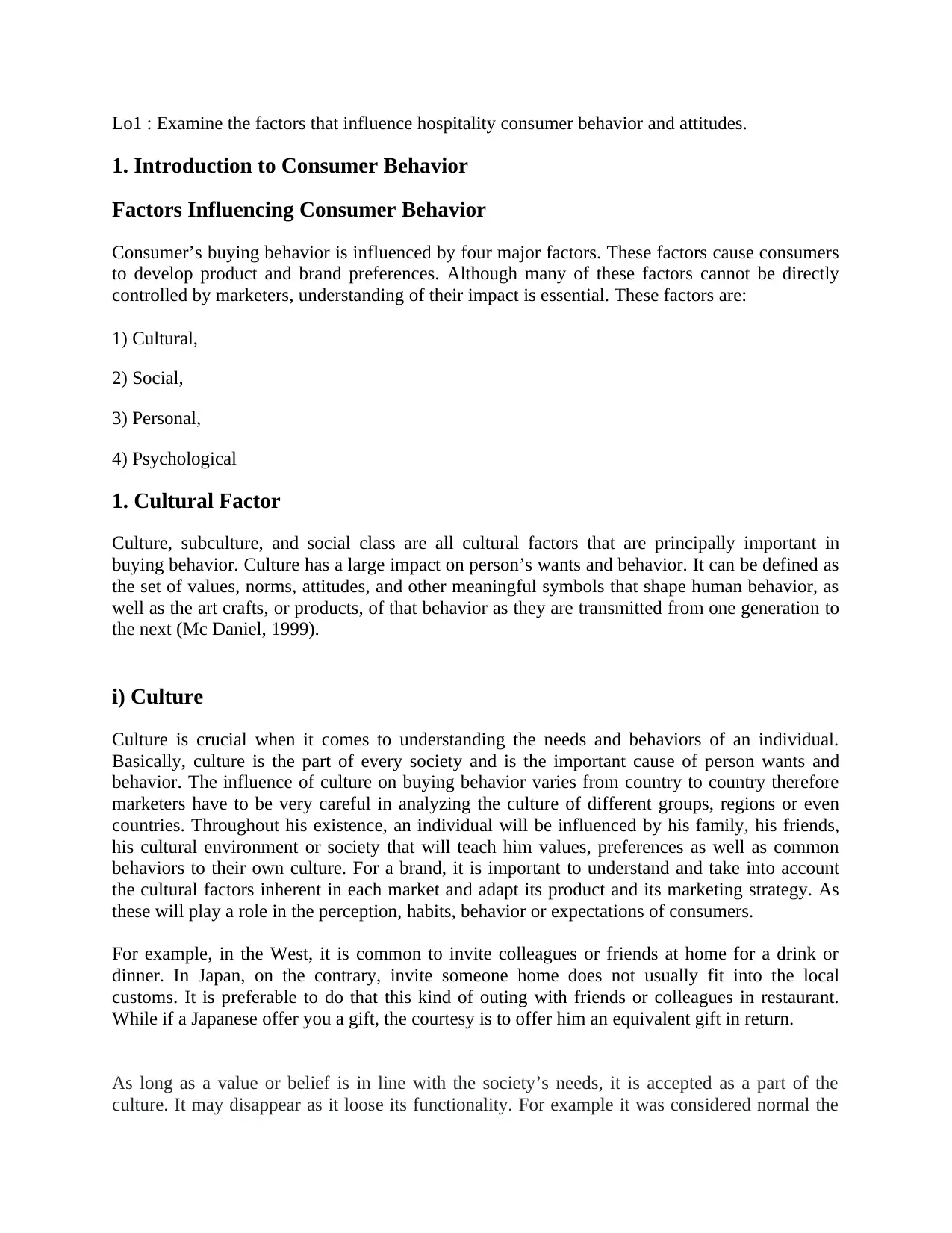
Lo1 : Examine the factors that influence hospitality consumer behavior and attitudes.
1. Introduction to Consumer Behavior
Factors Influencing Consumer Behavior
Consumer’s buying behavior is influenced by four major factors. These factors cause consumers
to develop product and brand preferences. Although many of these factors cannot be directly
controlled by marketers, understanding of their impact is essential. These factors are:
1) Cultural,
2) Social,
3) Personal,
4) Psychological
1. Cultural Factor
Culture, subculture, and social class are all cultural factors that are principally important in
buying behavior. Culture has a large impact on person’s wants and behavior. It can be defined as
the set of values, norms, attitudes, and other meaningful symbols that shape human behavior, as
well as the art crafts, or products, of that behavior as they are transmitted from one generation to
the next (Mc Daniel, 1999).
i) Culture
Culture is crucial when it comes to understanding the needs and behaviors of an individual.
Basically, culture is the part of every society and is the important cause of person wants and
behavior. The influence of culture on buying behavior varies from country to country therefore
marketers have to be very careful in analyzing the culture of different groups, regions or even
countries. Throughout his existence, an individual will be influenced by his family, his friends,
his cultural environment or society that will teach him values, preferences as well as common
behaviors to their own culture. For a brand, it is important to understand and take into account
the cultural factors inherent in each market and adapt its product and its marketing strategy. As
these will play a role in the perception, habits, behavior or expectations of consumers.
For example, in the West, it is common to invite colleagues or friends at home for a drink or
dinner. In Japan, on the contrary, invite someone home does not usually fit into the local
customs. It is preferable to do that this kind of outing with friends or colleagues in restaurant.
While if a Japanese offer you a gift, the courtesy is to offer him an equivalent gift in return.
As long as a value or belief is in line with the society’s needs, it is accepted as a part of the
culture. It may disappear as it loose its functionality. For example it was considered normal the
1. Introduction to Consumer Behavior
Factors Influencing Consumer Behavior
Consumer’s buying behavior is influenced by four major factors. These factors cause consumers
to develop product and brand preferences. Although many of these factors cannot be directly
controlled by marketers, understanding of their impact is essential. These factors are:
1) Cultural,
2) Social,
3) Personal,
4) Psychological
1. Cultural Factor
Culture, subculture, and social class are all cultural factors that are principally important in
buying behavior. Culture has a large impact on person’s wants and behavior. It can be defined as
the set of values, norms, attitudes, and other meaningful symbols that shape human behavior, as
well as the art crafts, or products, of that behavior as they are transmitted from one generation to
the next (Mc Daniel, 1999).
i) Culture
Culture is crucial when it comes to understanding the needs and behaviors of an individual.
Basically, culture is the part of every society and is the important cause of person wants and
behavior. The influence of culture on buying behavior varies from country to country therefore
marketers have to be very careful in analyzing the culture of different groups, regions or even
countries. Throughout his existence, an individual will be influenced by his family, his friends,
his cultural environment or society that will teach him values, preferences as well as common
behaviors to their own culture. For a brand, it is important to understand and take into account
the cultural factors inherent in each market and adapt its product and its marketing strategy. As
these will play a role in the perception, habits, behavior or expectations of consumers.
For example, in the West, it is common to invite colleagues or friends at home for a drink or
dinner. In Japan, on the contrary, invite someone home does not usually fit into the local
customs. It is preferable to do that this kind of outing with friends or colleagues in restaurant.
While if a Japanese offer you a gift, the courtesy is to offer him an equivalent gift in return.
As long as a value or belief is in line with the society’s needs, it is accepted as a part of the
culture. It may disappear as it loose its functionality. For example it was considered normal the
Secure Best Marks with AI Grader
Need help grading? Try our AI Grader for instant feedback on your assignments.
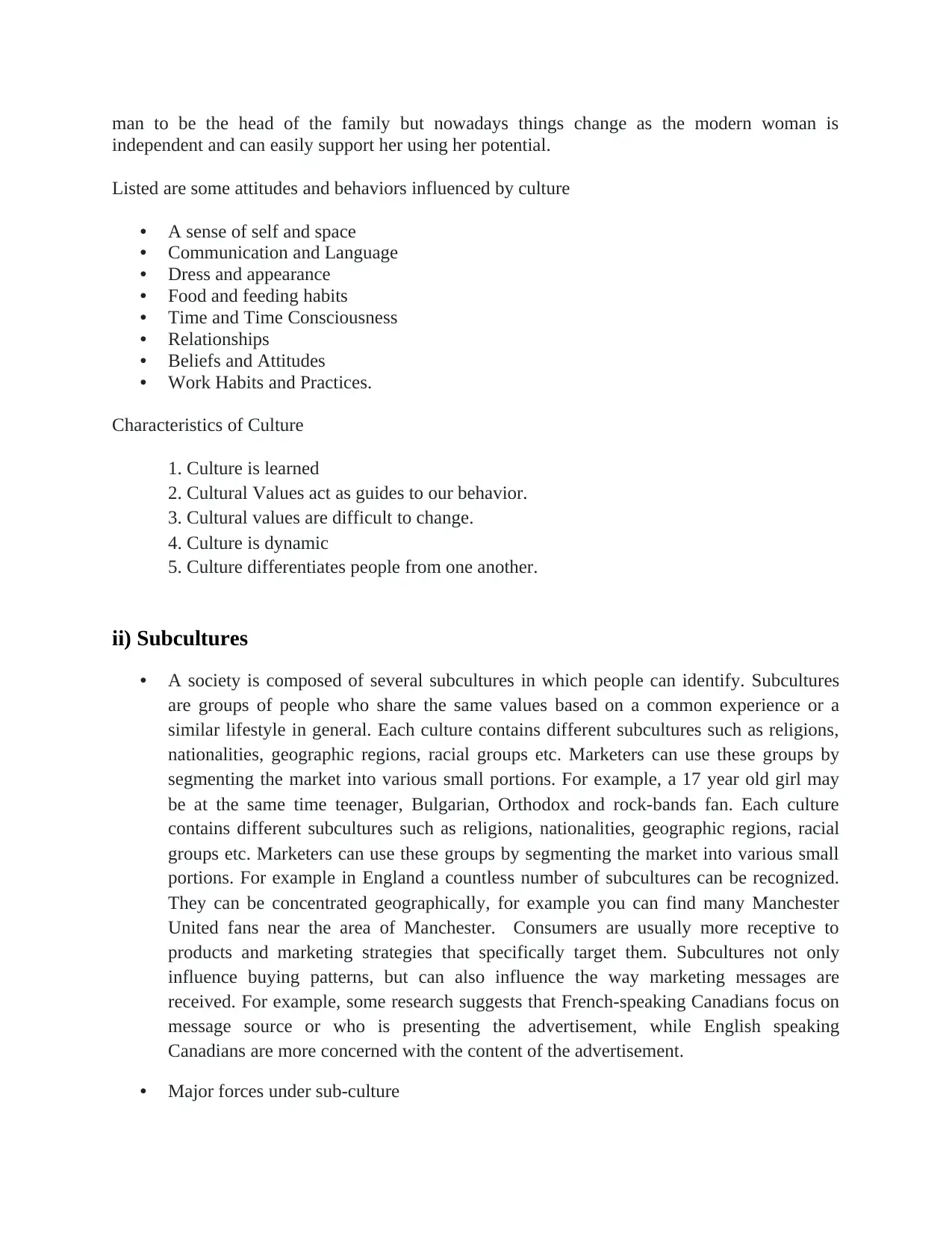
man to be the head of the family but nowadays things change as the modern woman is
independent and can easily support her using her potential.
Listed are some attitudes and behaviors influenced by culture
• A sense of self and space
• Communication and Language
• Dress and appearance
• Food and feeding habits
• Time and Time Consciousness
• Relationships
• Beliefs and Attitudes
• Work Habits and Practices.
Characteristics of Culture
1. Culture is learned
2. Cultural Values act as guides to our behavior.
3. Cultural values are difficult to change.
4. Culture is dynamic
5. Culture differentiates people from one another.
ii) Subcultures
• A society is composed of several subcultures in which people can identify. Subcultures
are groups of people who share the same values based on a common experience or a
similar lifestyle in general. Each culture contains different subcultures such as religions,
nationalities, geographic regions, racial groups etc. Marketers can use these groups by
segmenting the market into various small portions. For example, a 17 year old girl may
be at the same time teenager, Bulgarian, Orthodox and rock-bands fan. Each culture
contains different subcultures such as religions, nationalities, geographic regions, racial
groups etc. Marketers can use these groups by segmenting the market into various small
portions. For example in England a countless number of subcultures can be recognized.
They can be concentrated geographically, for example you can find many Manchester
United fans near the area of Manchester. Consumers are usually more receptive to
products and marketing strategies that specifically target them. Subcultures not only
influence buying patterns, but can also influence the way marketing messages are
received. For example, some research suggests that French-speaking Canadians focus on
message source or who is presenting the advertisement, while English speaking
Canadians are more concerned with the content of the advertisement.
• Major forces under sub-culture
independent and can easily support her using her potential.
Listed are some attitudes and behaviors influenced by culture
• A sense of self and space
• Communication and Language
• Dress and appearance
• Food and feeding habits
• Time and Time Consciousness
• Relationships
• Beliefs and Attitudes
• Work Habits and Practices.
Characteristics of Culture
1. Culture is learned
2. Cultural Values act as guides to our behavior.
3. Cultural values are difficult to change.
4. Culture is dynamic
5. Culture differentiates people from one another.
ii) Subcultures
• A society is composed of several subcultures in which people can identify. Subcultures
are groups of people who share the same values based on a common experience or a
similar lifestyle in general. Each culture contains different subcultures such as religions,
nationalities, geographic regions, racial groups etc. Marketers can use these groups by
segmenting the market into various small portions. For example, a 17 year old girl may
be at the same time teenager, Bulgarian, Orthodox and rock-bands fan. Each culture
contains different subcultures such as religions, nationalities, geographic regions, racial
groups etc. Marketers can use these groups by segmenting the market into various small
portions. For example in England a countless number of subcultures can be recognized.
They can be concentrated geographically, for example you can find many Manchester
United fans near the area of Manchester. Consumers are usually more receptive to
products and marketing strategies that specifically target them. Subcultures not only
influence buying patterns, but can also influence the way marketing messages are
received. For example, some research suggests that French-speaking Canadians focus on
message source or who is presenting the advertisement, while English speaking
Canadians are more concerned with the content of the advertisement.
• Major forces under sub-culture
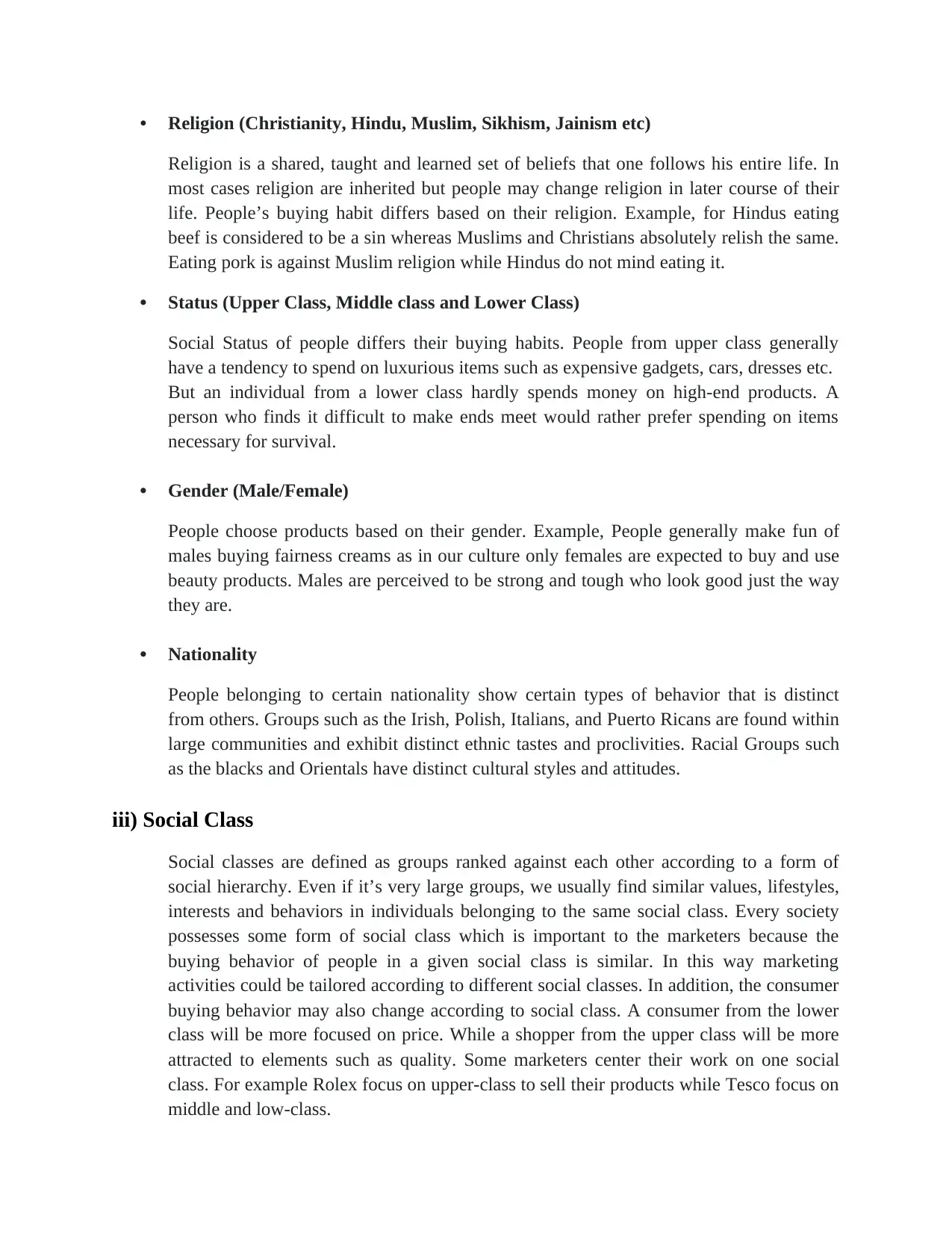
• Religion (Christianity, Hindu, Muslim, Sikhism, Jainism etc)
Religion is a shared, taught and learned set of beliefs that one follows his entire life. In
most cases religion are inherited but people may change religion in later course of their
life. People’s buying habit differs based on their religion. Example, for Hindus eating
beef is considered to be a sin whereas Muslims and Christians absolutely relish the same.
Eating pork is against Muslim religion while Hindus do not mind eating it.
• Status (Upper Class, Middle class and Lower Class)
Social Status of people differs their buying habits. People from upper class generally
have a tendency to spend on luxurious items such as expensive gadgets, cars, dresses etc.
But an individual from a lower class hardly spends money on high-end products. A
person who finds it difficult to make ends meet would rather prefer spending on items
necessary for survival.
• Gender (Male/Female)
People choose products based on their gender. Example, People generally make fun of
males buying fairness creams as in our culture only females are expected to buy and use
beauty products. Males are perceived to be strong and tough who look good just the way
they are.
• Nationality
People belonging to certain nationality show certain types of behavior that is distinct
from others. Groups such as the Irish, Polish, Italians, and Puerto Ricans are found within
large communities and exhibit distinct ethnic tastes and proclivities. Racial Groups such
as the blacks and Orientals have distinct cultural styles and attitudes.
iii) Social Class
Social classes are defined as groups ranked against each other according to a form of
social hierarchy. Even if it’s very large groups, we usually find similar values, lifestyles,
interests and behaviors in individuals belonging to the same social class. Every society
possesses some form of social class which is important to the marketers because the
buying behavior of people in a given social class is similar. In this way marketing
activities could be tailored according to different social classes. In addition, the consumer
buying behavior may also change according to social class. A consumer from the lower
class will be more focused on price. While a shopper from the upper class will be more
attracted to elements such as quality. Some marketers center their work on one social
class. For example Rolex focus on upper-class to sell their products while Tesco focus on
middle and low-class.
Religion is a shared, taught and learned set of beliefs that one follows his entire life. In
most cases religion are inherited but people may change religion in later course of their
life. People’s buying habit differs based on their religion. Example, for Hindus eating
beef is considered to be a sin whereas Muslims and Christians absolutely relish the same.
Eating pork is against Muslim religion while Hindus do not mind eating it.
• Status (Upper Class, Middle class and Lower Class)
Social Status of people differs their buying habits. People from upper class generally
have a tendency to spend on luxurious items such as expensive gadgets, cars, dresses etc.
But an individual from a lower class hardly spends money on high-end products. A
person who finds it difficult to make ends meet would rather prefer spending on items
necessary for survival.
• Gender (Male/Female)
People choose products based on their gender. Example, People generally make fun of
males buying fairness creams as in our culture only females are expected to buy and use
beauty products. Males are perceived to be strong and tough who look good just the way
they are.
• Nationality
People belonging to certain nationality show certain types of behavior that is distinct
from others. Groups such as the Irish, Polish, Italians, and Puerto Ricans are found within
large communities and exhibit distinct ethnic tastes and proclivities. Racial Groups such
as the blacks and Orientals have distinct cultural styles and attitudes.
iii) Social Class
Social classes are defined as groups ranked against each other according to a form of
social hierarchy. Even if it’s very large groups, we usually find similar values, lifestyles,
interests and behaviors in individuals belonging to the same social class. Every society
possesses some form of social class which is important to the marketers because the
buying behavior of people in a given social class is similar. In this way marketing
activities could be tailored according to different social classes. In addition, the consumer
buying behavior may also change according to social class. A consumer from the lower
class will be more focused on price. While a shopper from the upper class will be more
attracted to elements such as quality. Some marketers center their work on one social
class. For example Rolex focus on upper-class to sell their products while Tesco focus on
middle and low-class.
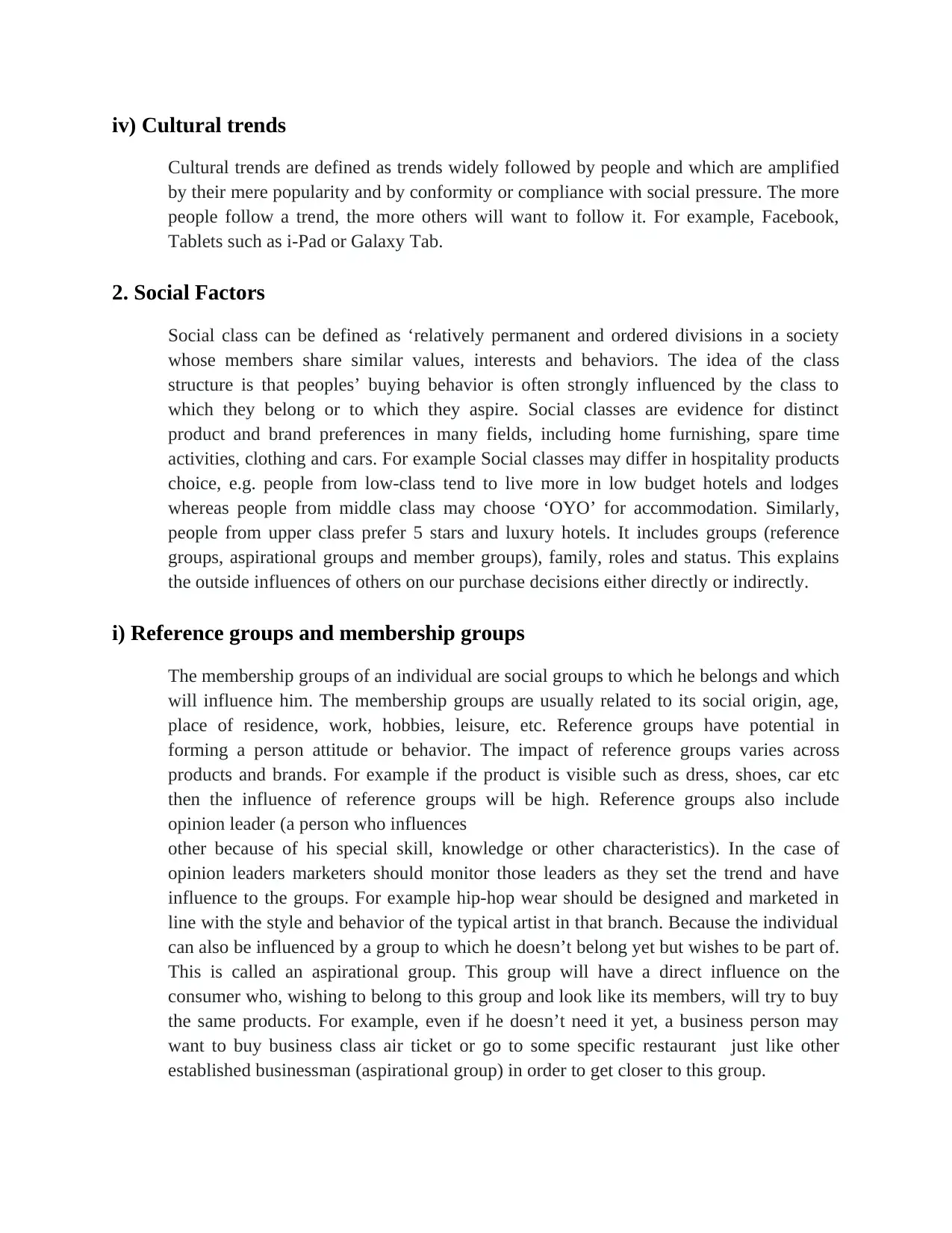
iv) Cultural trends
Cultural trends are defined as trends widely followed by people and which are amplified
by their mere popularity and by conformity or compliance with social pressure. The more
people follow a trend, the more others will want to follow it. For example, Facebook,
Tablets such as i-Pad or Galaxy Tab.
2. Social Factors
Social class can be defined as ‘relatively permanent and ordered divisions in a society
whose members share similar values, interests and behaviors. The idea of the class
structure is that peoples’ buying behavior is often strongly influenced by the class to
which they belong or to which they aspire. Social classes are evidence for distinct
product and brand preferences in many fields, including home furnishing, spare time
activities, clothing and cars. For example Social classes may differ in hospitality products
choice, e.g. people from low-class tend to live more in low budget hotels and lodges
whereas people from middle class may choose ‘OYO’ for accommodation. Similarly,
people from upper class prefer 5 stars and luxury hotels. It includes groups (reference
groups, aspirational groups and member groups), family, roles and status. This explains
the outside influences of others on our purchase decisions either directly or indirectly.
i) Reference groups and membership groups
The membership groups of an individual are social groups to which he belongs and which
will influence him. The membership groups are usually related to its social origin, age,
place of residence, work, hobbies, leisure, etc. Reference groups have potential in
forming a person attitude or behavior. The impact of reference groups varies across
products and brands. For example if the product is visible such as dress, shoes, car etc
then the influence of reference groups will be high. Reference groups also include
opinion leader (a person who influences
other because of his special skill, knowledge or other characteristics). In the case of
opinion leaders marketers should monitor those leaders as they set the trend and have
influence to the groups. For example hip-hop wear should be designed and marketed in
line with the style and behavior of the typical artist in that branch. Because the individual
can also be influenced by a group to which he doesn’t belong yet but wishes to be part of.
This is called an aspirational group. This group will have a direct influence on the
consumer who, wishing to belong to this group and look like its members, will try to buy
the same products. For example, even if he doesn’t need it yet, a business person may
want to buy business class air ticket or go to some specific restaurant just like other
established businessman (aspirational group) in order to get closer to this group.
Cultural trends are defined as trends widely followed by people and which are amplified
by their mere popularity and by conformity or compliance with social pressure. The more
people follow a trend, the more others will want to follow it. For example, Facebook,
Tablets such as i-Pad or Galaxy Tab.
2. Social Factors
Social class can be defined as ‘relatively permanent and ordered divisions in a society
whose members share similar values, interests and behaviors. The idea of the class
structure is that peoples’ buying behavior is often strongly influenced by the class to
which they belong or to which they aspire. Social classes are evidence for distinct
product and brand preferences in many fields, including home furnishing, spare time
activities, clothing and cars. For example Social classes may differ in hospitality products
choice, e.g. people from low-class tend to live more in low budget hotels and lodges
whereas people from middle class may choose ‘OYO’ for accommodation. Similarly,
people from upper class prefer 5 stars and luxury hotels. It includes groups (reference
groups, aspirational groups and member groups), family, roles and status. This explains
the outside influences of others on our purchase decisions either directly or indirectly.
i) Reference groups and membership groups
The membership groups of an individual are social groups to which he belongs and which
will influence him. The membership groups are usually related to its social origin, age,
place of residence, work, hobbies, leisure, etc. Reference groups have potential in
forming a person attitude or behavior. The impact of reference groups varies across
products and brands. For example if the product is visible such as dress, shoes, car etc
then the influence of reference groups will be high. Reference groups also include
opinion leader (a person who influences
other because of his special skill, knowledge or other characteristics). In the case of
opinion leaders marketers should monitor those leaders as they set the trend and have
influence to the groups. For example hip-hop wear should be designed and marketed in
line with the style and behavior of the typical artist in that branch. Because the individual
can also be influenced by a group to which he doesn’t belong yet but wishes to be part of.
This is called an aspirational group. This group will have a direct influence on the
consumer who, wishing to belong to this group and look like its members, will try to buy
the same products. For example, even if he doesn’t need it yet, a business person may
want to buy business class air ticket or go to some specific restaurant just like other
established businessman (aspirational group) in order to get closer to this group.
Secure Best Marks with AI Grader
Need help grading? Try our AI Grader for instant feedback on your assignments.
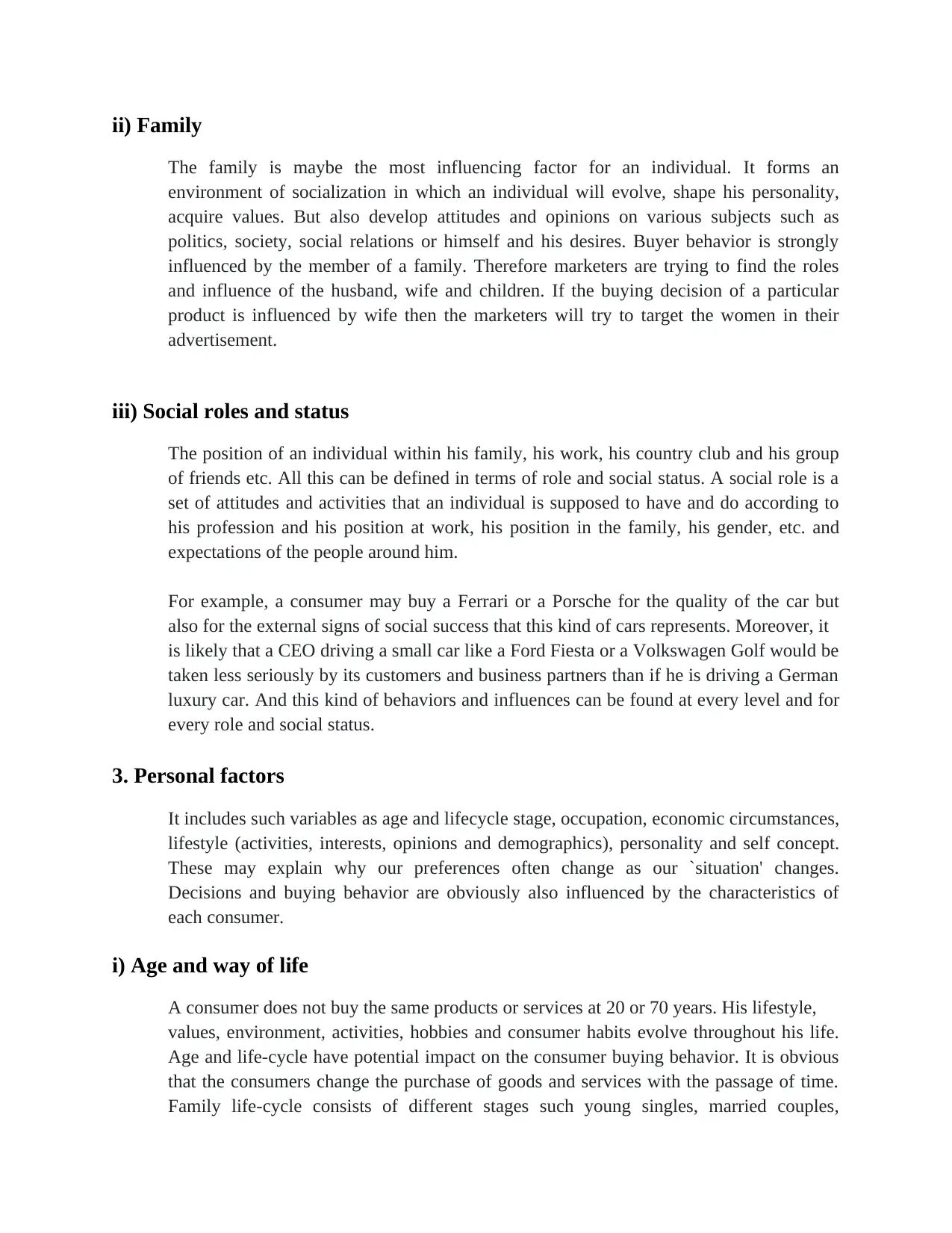
ii) Family
The family is maybe the most influencing factor for an individual. It forms an
environment of socialization in which an individual will evolve, shape his personality,
acquire values. But also develop attitudes and opinions on various subjects such as
politics, society, social relations or himself and his desires. Buyer behavior is strongly
influenced by the member of a family. Therefore marketers are trying to find the roles
and influence of the husband, wife and children. If the buying decision of a particular
product is influenced by wife then the marketers will try to target the women in their
advertisement.
iii) Social roles and status
The position of an individual within his family, his work, his country club and his group
of friends etc. All this can be defined in terms of role and social status. A social role is a
set of attitudes and activities that an individual is supposed to have and do according to
his profession and his position at work, his position in the family, his gender, etc. and
expectations of the people around him.
For example, a consumer may buy a Ferrari or a Porsche for the quality of the car but
also for the external signs of social success that this kind of cars represents. Moreover, it
is likely that a CEO driving a small car like a Ford Fiesta or a Volkswagen Golf would be
taken less seriously by its customers and business partners than if he is driving a German
luxury car. And this kind of behaviors and influences can be found at every level and for
every role and social status.
3. Personal factors
It includes such variables as age and lifecycle stage, occupation, economic circumstances,
lifestyle (activities, interests, opinions and demographics), personality and self concept.
These may explain why our preferences often change as our `situation' changes.
Decisions and buying behavior are obviously also influenced by the characteristics of
each consumer.
i) Age and way of life
A consumer does not buy the same products or services at 20 or 70 years. His lifestyle,
values, environment, activities, hobbies and consumer habits evolve throughout his life.
Age and life-cycle have potential impact on the consumer buying behavior. It is obvious
that the consumers change the purchase of goods and services with the passage of time.
Family life-cycle consists of different stages such young singles, married couples,
The family is maybe the most influencing factor for an individual. It forms an
environment of socialization in which an individual will evolve, shape his personality,
acquire values. But also develop attitudes and opinions on various subjects such as
politics, society, social relations or himself and his desires. Buyer behavior is strongly
influenced by the member of a family. Therefore marketers are trying to find the roles
and influence of the husband, wife and children. If the buying decision of a particular
product is influenced by wife then the marketers will try to target the women in their
advertisement.
iii) Social roles and status
The position of an individual within his family, his work, his country club and his group
of friends etc. All this can be defined in terms of role and social status. A social role is a
set of attitudes and activities that an individual is supposed to have and do according to
his profession and his position at work, his position in the family, his gender, etc. and
expectations of the people around him.
For example, a consumer may buy a Ferrari or a Porsche for the quality of the car but
also for the external signs of social success that this kind of cars represents. Moreover, it
is likely that a CEO driving a small car like a Ford Fiesta or a Volkswagen Golf would be
taken less seriously by its customers and business partners than if he is driving a German
luxury car. And this kind of behaviors and influences can be found at every level and for
every role and social status.
3. Personal factors
It includes such variables as age and lifecycle stage, occupation, economic circumstances,
lifestyle (activities, interests, opinions and demographics), personality and self concept.
These may explain why our preferences often change as our `situation' changes.
Decisions and buying behavior are obviously also influenced by the characteristics of
each consumer.
i) Age and way of life
A consumer does not buy the same products or services at 20 or 70 years. His lifestyle,
values, environment, activities, hobbies and consumer habits evolve throughout his life.
Age and life-cycle have potential impact on the consumer buying behavior. It is obvious
that the consumers change the purchase of goods and services with the passage of time.
Family life-cycle consists of different stages such young singles, married couples,
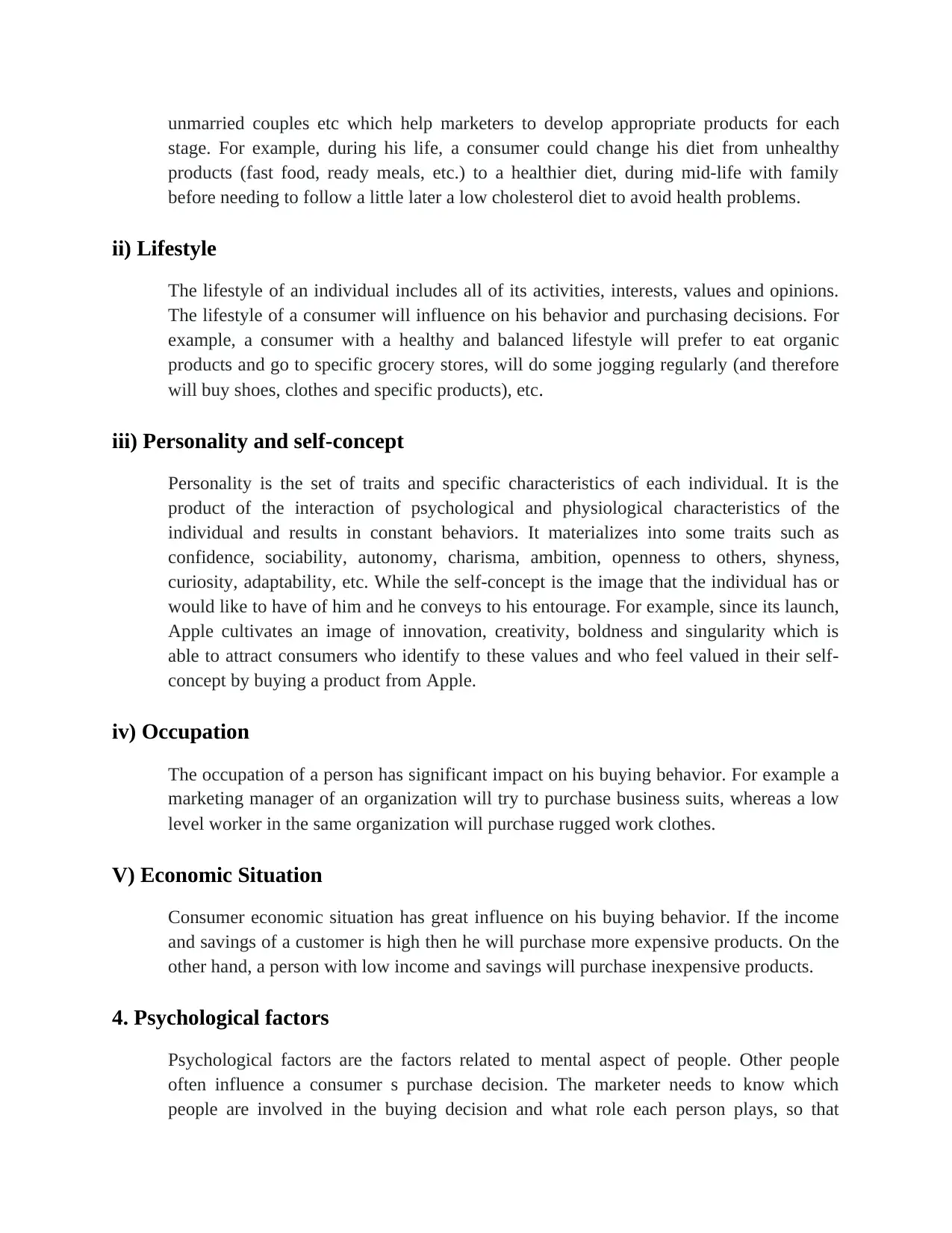
unmarried couples etc which help marketers to develop appropriate products for each
stage. For example, during his life, a consumer could change his diet from unhealthy
products (fast food, ready meals, etc.) to a healthier diet, during mid-life with family
before needing to follow a little later a low cholesterol diet to avoid health problems.
ii) Lifestyle
The lifestyle of an individual includes all of its activities, interests, values and opinions.
The lifestyle of a consumer will influence on his behavior and purchasing decisions. For
example, a consumer with a healthy and balanced lifestyle will prefer to eat organic
products and go to specific grocery stores, will do some jogging regularly (and therefore
will buy shoes, clothes and specific products), etc.
iii) Personality and self-concept
Personality is the set of traits and specific characteristics of each individual. It is the
product of the interaction of psychological and physiological characteristics of the
individual and results in constant behaviors. It materializes into some traits such as
confidence, sociability, autonomy, charisma, ambition, openness to others, shyness,
curiosity, adaptability, etc. While the self-concept is the image that the individual has or
would like to have of him and he conveys to his entourage. For example, since its launch,
Apple cultivates an image of innovation, creativity, boldness and singularity which is
able to attract consumers who identify to these values and who feel valued in their self-
concept by buying a product from Apple.
iv) Occupation
The occupation of a person has significant impact on his buying behavior. For example a
marketing manager of an organization will try to purchase business suits, whereas a low
level worker in the same organization will purchase rugged work clothes.
V) Economic Situation
Consumer economic situation has great influence on his buying behavior. If the income
and savings of a customer is high then he will purchase more expensive products. On the
other hand, a person with low income and savings will purchase inexpensive products.
4. Psychological factors
Psychological factors are the factors related to mental aspect of people. Other people
often influence a consumer s purchase decision. The marketer needs to know which
people are involved in the buying decision and what role each person plays, so that
stage. For example, during his life, a consumer could change his diet from unhealthy
products (fast food, ready meals, etc.) to a healthier diet, during mid-life with family
before needing to follow a little later a low cholesterol diet to avoid health problems.
ii) Lifestyle
The lifestyle of an individual includes all of its activities, interests, values and opinions.
The lifestyle of a consumer will influence on his behavior and purchasing decisions. For
example, a consumer with a healthy and balanced lifestyle will prefer to eat organic
products and go to specific grocery stores, will do some jogging regularly (and therefore
will buy shoes, clothes and specific products), etc.
iii) Personality and self-concept
Personality is the set of traits and specific characteristics of each individual. It is the
product of the interaction of psychological and physiological characteristics of the
individual and results in constant behaviors. It materializes into some traits such as
confidence, sociability, autonomy, charisma, ambition, openness to others, shyness,
curiosity, adaptability, etc. While the self-concept is the image that the individual has or
would like to have of him and he conveys to his entourage. For example, since its launch,
Apple cultivates an image of innovation, creativity, boldness and singularity which is
able to attract consumers who identify to these values and who feel valued in their self-
concept by buying a product from Apple.
iv) Occupation
The occupation of a person has significant impact on his buying behavior. For example a
marketing manager of an organization will try to purchase business suits, whereas a low
level worker in the same organization will purchase rugged work clothes.
V) Economic Situation
Consumer economic situation has great influence on his buying behavior. If the income
and savings of a customer is high then he will purchase more expensive products. On the
other hand, a person with low income and savings will purchase inexpensive products.
4. Psychological factors
Psychological factors are the factors related to mental aspect of people. Other people
often influence a consumer s purchase decision. The marketer needs to know which
people are involved in the buying decision and what role each person plays, so that
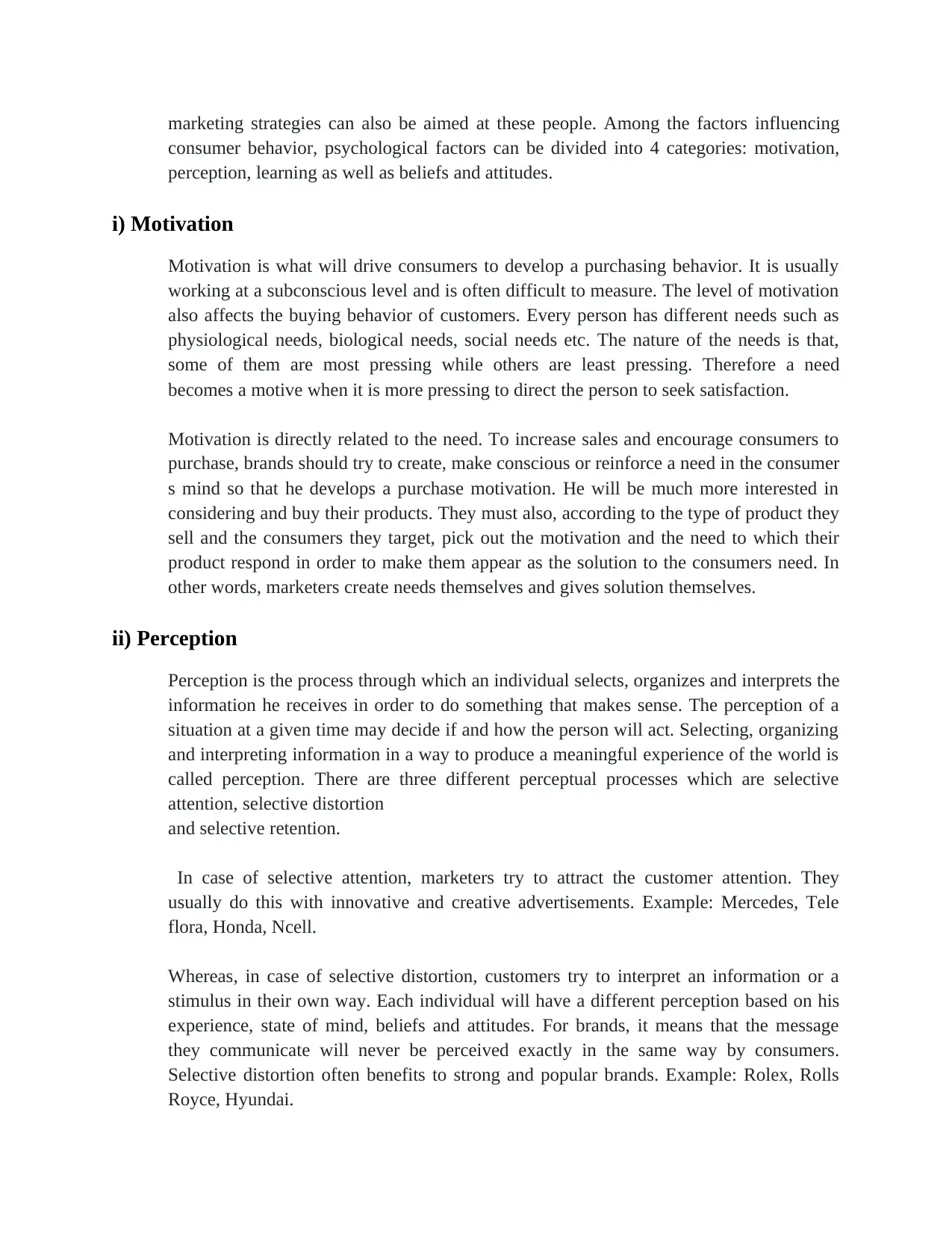
marketing strategies can also be aimed at these people. Among the factors influencing
consumer behavior, psychological factors can be divided into 4 categories: motivation,
perception, learning as well as beliefs and attitudes.
i) Motivation
Motivation is what will drive consumers to develop a purchasing behavior. It is usually
working at a subconscious level and is often difficult to measure. The level of motivation
also affects the buying behavior of customers. Every person has different needs such as
physiological needs, biological needs, social needs etc. The nature of the needs is that,
some of them are most pressing while others are least pressing. Therefore a need
becomes a motive when it is more pressing to direct the person to seek satisfaction.
Motivation is directly related to the need. To increase sales and encourage consumers to
purchase, brands should try to create, make conscious or reinforce a need in the consumer
s mind so that he develops a purchase motivation. He will be much more interested in
considering and buy their products. They must also, according to the type of product they
sell and the consumers they target, pick out the motivation and the need to which their
product respond in order to make them appear as the solution to the consumers need. In
other words, marketers create needs themselves and gives solution themselves.
ii) Perception
Perception is the process through which an individual selects, organizes and interprets the
information he receives in order to do something that makes sense. The perception of a
situation at a given time may decide if and how the person will act. Selecting, organizing
and interpreting information in a way to produce a meaningful experience of the world is
called perception. There are three different perceptual processes which are selective
attention, selective distortion
and selective retention.
In case of selective attention, marketers try to attract the customer attention. They
usually do this with innovative and creative advertisements. Example: Mercedes, Tele
flora, Honda, Ncell.
Whereas, in case of selective distortion, customers try to interpret an information or a
stimulus in their own way. Each individual will have a different perception based on his
experience, state of mind, beliefs and attitudes. For brands, it means that the message
they communicate will never be perceived exactly in the same way by consumers.
Selective distortion often benefits to strong and popular brands. Example: Rolex, Rolls
Royce, Hyundai.
consumer behavior, psychological factors can be divided into 4 categories: motivation,
perception, learning as well as beliefs and attitudes.
i) Motivation
Motivation is what will drive consumers to develop a purchasing behavior. It is usually
working at a subconscious level and is often difficult to measure. The level of motivation
also affects the buying behavior of customers. Every person has different needs such as
physiological needs, biological needs, social needs etc. The nature of the needs is that,
some of them are most pressing while others are least pressing. Therefore a need
becomes a motive when it is more pressing to direct the person to seek satisfaction.
Motivation is directly related to the need. To increase sales and encourage consumers to
purchase, brands should try to create, make conscious or reinforce a need in the consumer
s mind so that he develops a purchase motivation. He will be much more interested in
considering and buy their products. They must also, according to the type of product they
sell and the consumers they target, pick out the motivation and the need to which their
product respond in order to make them appear as the solution to the consumers need. In
other words, marketers create needs themselves and gives solution themselves.
ii) Perception
Perception is the process through which an individual selects, organizes and interprets the
information he receives in order to do something that makes sense. The perception of a
situation at a given time may decide if and how the person will act. Selecting, organizing
and interpreting information in a way to produce a meaningful experience of the world is
called perception. There are three different perceptual processes which are selective
attention, selective distortion
and selective retention.
In case of selective attention, marketers try to attract the customer attention. They
usually do this with innovative and creative advertisements. Example: Mercedes, Tele
flora, Honda, Ncell.
Whereas, in case of selective distortion, customers try to interpret an information or a
stimulus in their own way. Each individual will have a different perception based on his
experience, state of mind, beliefs and attitudes. For brands, it means that the message
they communicate will never be perceived exactly in the same way by consumers.
Selective distortion often benefits to strong and popular brands. Example: Rolex, Rolls
Royce, Hyundai.
Paraphrase This Document
Need a fresh take? Get an instant paraphrase of this document with our AI Paraphraser
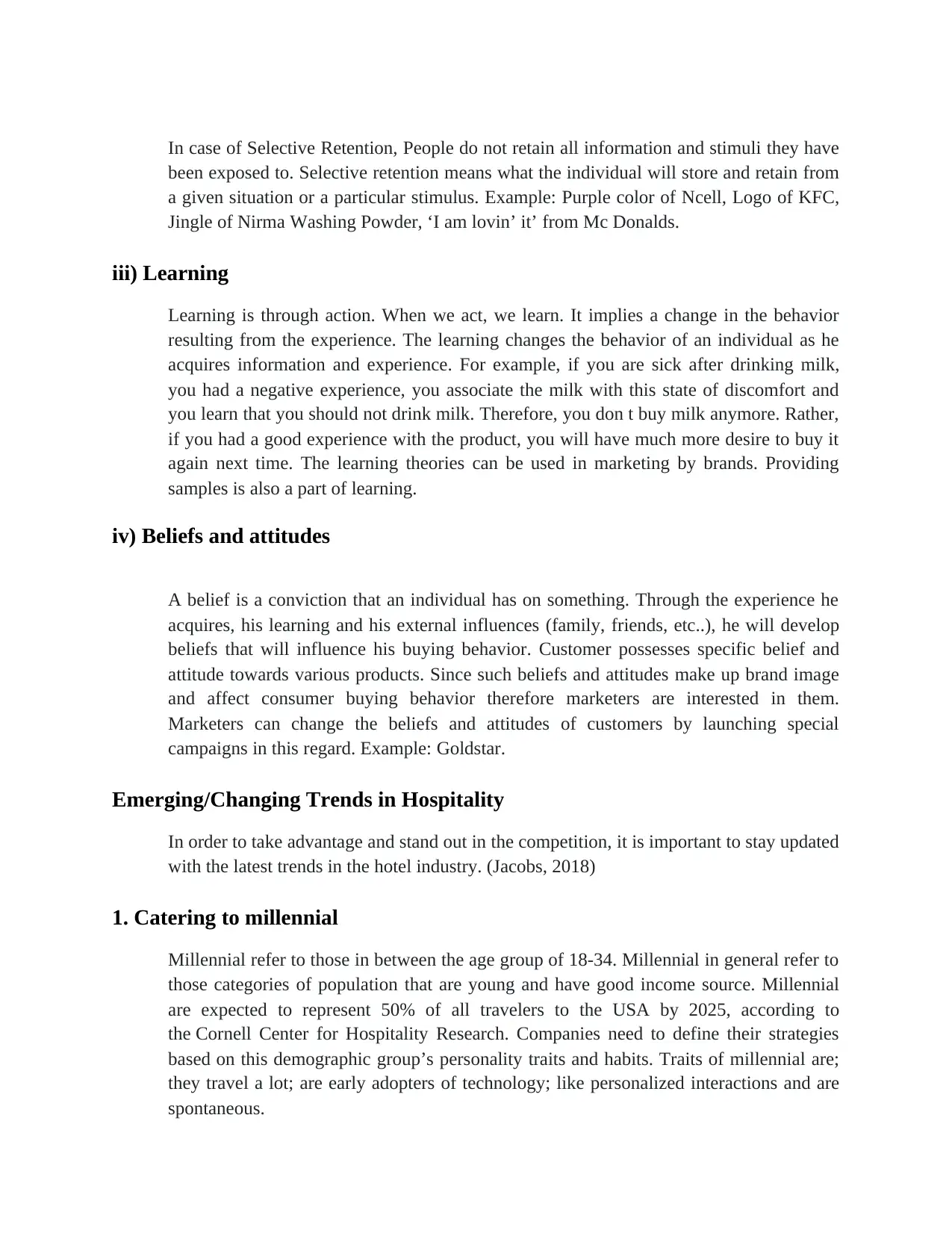
In case of Selective Retention, People do not retain all information and stimuli they have
been exposed to. Selective retention means what the individual will store and retain from
a given situation or a particular stimulus. Example: Purple color of Ncell, Logo of KFC,
Jingle of Nirma Washing Powder, ‘I am lovin’ it’ from Mc Donalds.
iii) Learning
Learning is through action. When we act, we learn. It implies a change in the behavior
resulting from the experience. The learning changes the behavior of an individual as he
acquires information and experience. For example, if you are sick after drinking milk,
you had a negative experience, you associate the milk with this state of discomfort and
you learn that you should not drink milk. Therefore, you don t buy milk anymore. Rather,
if you had a good experience with the product, you will have much more desire to buy it
again next time. The learning theories can be used in marketing by brands. Providing
samples is also a part of learning.
iv) Beliefs and attitudes
A belief is a conviction that an individual has on something. Through the experience he
acquires, his learning and his external influences (family, friends, etc..), he will develop
beliefs that will influence his buying behavior. Customer possesses specific belief and
attitude towards various products. Since such beliefs and attitudes make up brand image
and affect consumer buying behavior therefore marketers are interested in them.
Marketers can change the beliefs and attitudes of customers by launching special
campaigns in this regard. Example: Goldstar.
Emerging/Changing Trends in Hospitality
In order to take advantage and stand out in the competition, it is important to stay updated
with the latest trends in the hotel industry. (Jacobs, 2018)
1. Catering to millennial
Millennial refer to those in between the age group of 18-34. Millennial in general refer to
those categories of population that are young and have good income source. Millennial
are expected to represent 50% of all travelers to the USA by 2025, according to
the Cornell Center for Hospitality Research. Companies need to define their strategies
based on this demographic group’s personality traits and habits. Traits of millennial are;
they travel a lot; are early adopters of technology; like personalized interactions and are
spontaneous.
been exposed to. Selective retention means what the individual will store and retain from
a given situation or a particular stimulus. Example: Purple color of Ncell, Logo of KFC,
Jingle of Nirma Washing Powder, ‘I am lovin’ it’ from Mc Donalds.
iii) Learning
Learning is through action. When we act, we learn. It implies a change in the behavior
resulting from the experience. The learning changes the behavior of an individual as he
acquires information and experience. For example, if you are sick after drinking milk,
you had a negative experience, you associate the milk with this state of discomfort and
you learn that you should not drink milk. Therefore, you don t buy milk anymore. Rather,
if you had a good experience with the product, you will have much more desire to buy it
again next time. The learning theories can be used in marketing by brands. Providing
samples is also a part of learning.
iv) Beliefs and attitudes
A belief is a conviction that an individual has on something. Through the experience he
acquires, his learning and his external influences (family, friends, etc..), he will develop
beliefs that will influence his buying behavior. Customer possesses specific belief and
attitude towards various products. Since such beliefs and attitudes make up brand image
and affect consumer buying behavior therefore marketers are interested in them.
Marketers can change the beliefs and attitudes of customers by launching special
campaigns in this regard. Example: Goldstar.
Emerging/Changing Trends in Hospitality
In order to take advantage and stand out in the competition, it is important to stay updated
with the latest trends in the hotel industry. (Jacobs, 2018)
1. Catering to millennial
Millennial refer to those in between the age group of 18-34. Millennial in general refer to
those categories of population that are young and have good income source. Millennial
are expected to represent 50% of all travelers to the USA by 2025, according to
the Cornell Center for Hospitality Research. Companies need to define their strategies
based on this demographic group’s personality traits and habits. Traits of millennial are;
they travel a lot; are early adopters of technology; like personalized interactions and are
spontaneous.
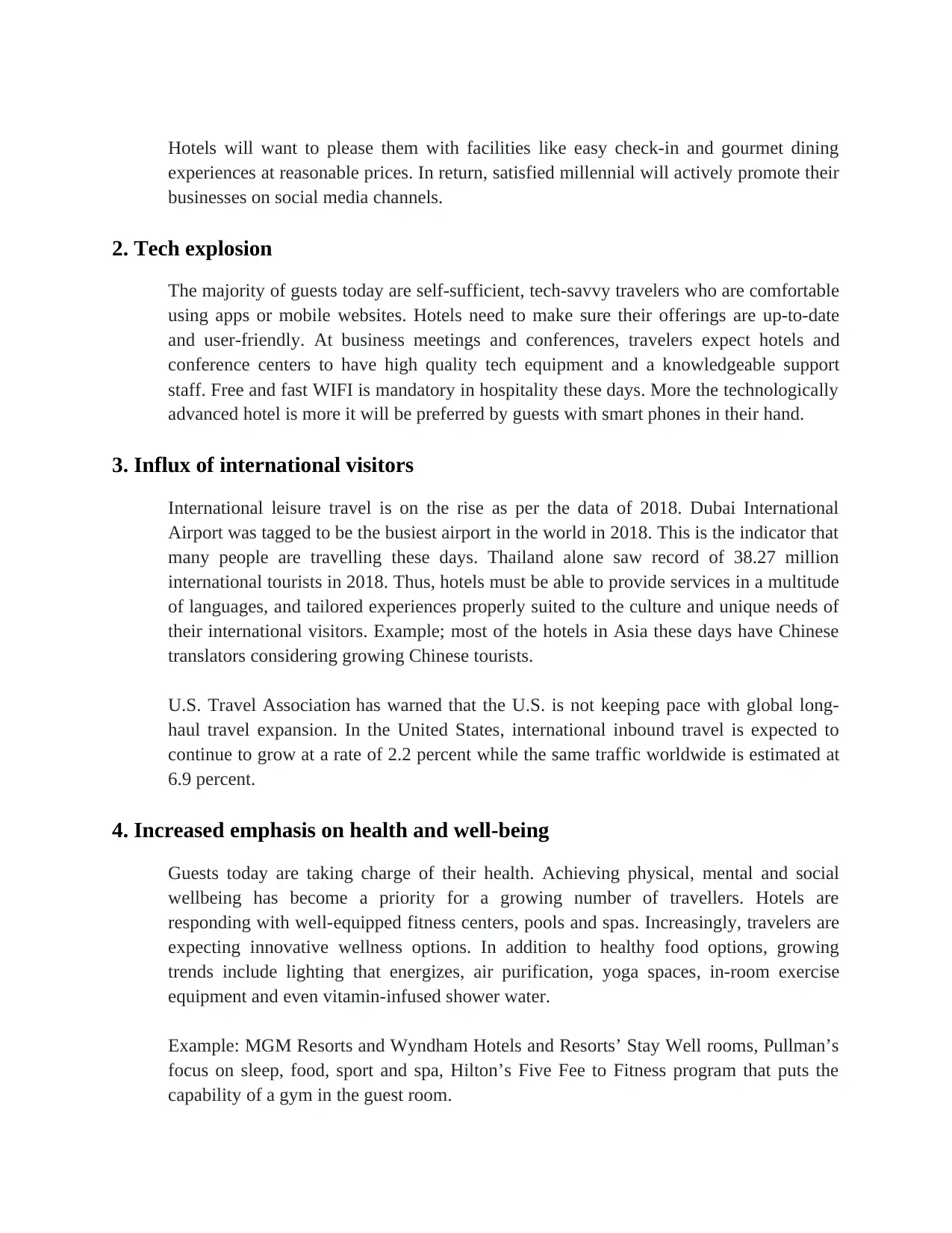
Hotels will want to please them with facilities like easy check-in and gourmet dining
experiences at reasonable prices. In return, satisfied millennial will actively promote their
businesses on social media channels.
2. Tech explosion
The majority of guests today are self-sufficient, tech-savvy travelers who are comfortable
using apps or mobile websites. Hotels need to make sure their offerings are up-to-date
and user-friendly. At business meetings and conferences, travelers expect hotels and
conference centers to have high quality tech equipment and a knowledgeable support
staff. Free and fast WIFI is mandatory in hospitality these days. More the technologically
advanced hotel is more it will be preferred by guests with smart phones in their hand.
3. Influx of international visitors
International leisure travel is on the rise as per the data of 2018. Dubai International
Airport was tagged to be the busiest airport in the world in 2018. This is the indicator that
many people are travelling these days. Thailand alone saw record of 38.27 million
international tourists in 2018. Thus, hotels must be able to provide services in a multitude
of languages, and tailored experiences properly suited to the culture and unique needs of
their international visitors. Example; most of the hotels in Asia these days have Chinese
translators considering growing Chinese tourists.
U.S. Travel Association has warned that the U.S. is not keeping pace with global long-
haul travel expansion. In the United States, international inbound travel is expected to
continue to grow at a rate of 2.2 percent while the same traffic worldwide is estimated at
6.9 percent.
4. Increased emphasis on health and well-being
Guests today are taking charge of their health. Achieving physical, mental and social
wellbeing has become a priority for a growing number of travellers. Hotels are
responding with well-equipped fitness centers, pools and spas. Increasingly, travelers are
expecting innovative wellness options. In addition to healthy food options, growing
trends include lighting that energizes, air purification, yoga spaces, in-room exercise
equipment and even vitamin-infused shower water.
Example: MGM Resorts and Wyndham Hotels and Resorts’ Stay Well rooms, Pullman’s
focus on sleep, food, sport and spa, Hilton’s Five Fee to Fitness program that puts the
capability of a gym in the guest room.
experiences at reasonable prices. In return, satisfied millennial will actively promote their
businesses on social media channels.
2. Tech explosion
The majority of guests today are self-sufficient, tech-savvy travelers who are comfortable
using apps or mobile websites. Hotels need to make sure their offerings are up-to-date
and user-friendly. At business meetings and conferences, travelers expect hotels and
conference centers to have high quality tech equipment and a knowledgeable support
staff. Free and fast WIFI is mandatory in hospitality these days. More the technologically
advanced hotel is more it will be preferred by guests with smart phones in their hand.
3. Influx of international visitors
International leisure travel is on the rise as per the data of 2018. Dubai International
Airport was tagged to be the busiest airport in the world in 2018. This is the indicator that
many people are travelling these days. Thailand alone saw record of 38.27 million
international tourists in 2018. Thus, hotels must be able to provide services in a multitude
of languages, and tailored experiences properly suited to the culture and unique needs of
their international visitors. Example; most of the hotels in Asia these days have Chinese
translators considering growing Chinese tourists.
U.S. Travel Association has warned that the U.S. is not keeping pace with global long-
haul travel expansion. In the United States, international inbound travel is expected to
continue to grow at a rate of 2.2 percent while the same traffic worldwide is estimated at
6.9 percent.
4. Increased emphasis on health and well-being
Guests today are taking charge of their health. Achieving physical, mental and social
wellbeing has become a priority for a growing number of travellers. Hotels are
responding with well-equipped fitness centers, pools and spas. Increasingly, travelers are
expecting innovative wellness options. In addition to healthy food options, growing
trends include lighting that energizes, air purification, yoga spaces, in-room exercise
equipment and even vitamin-infused shower water.
Example: MGM Resorts and Wyndham Hotels and Resorts’ Stay Well rooms, Pullman’s
focus on sleep, food, sport and spa, Hilton’s Five Fee to Fitness program that puts the
capability of a gym in the guest room.
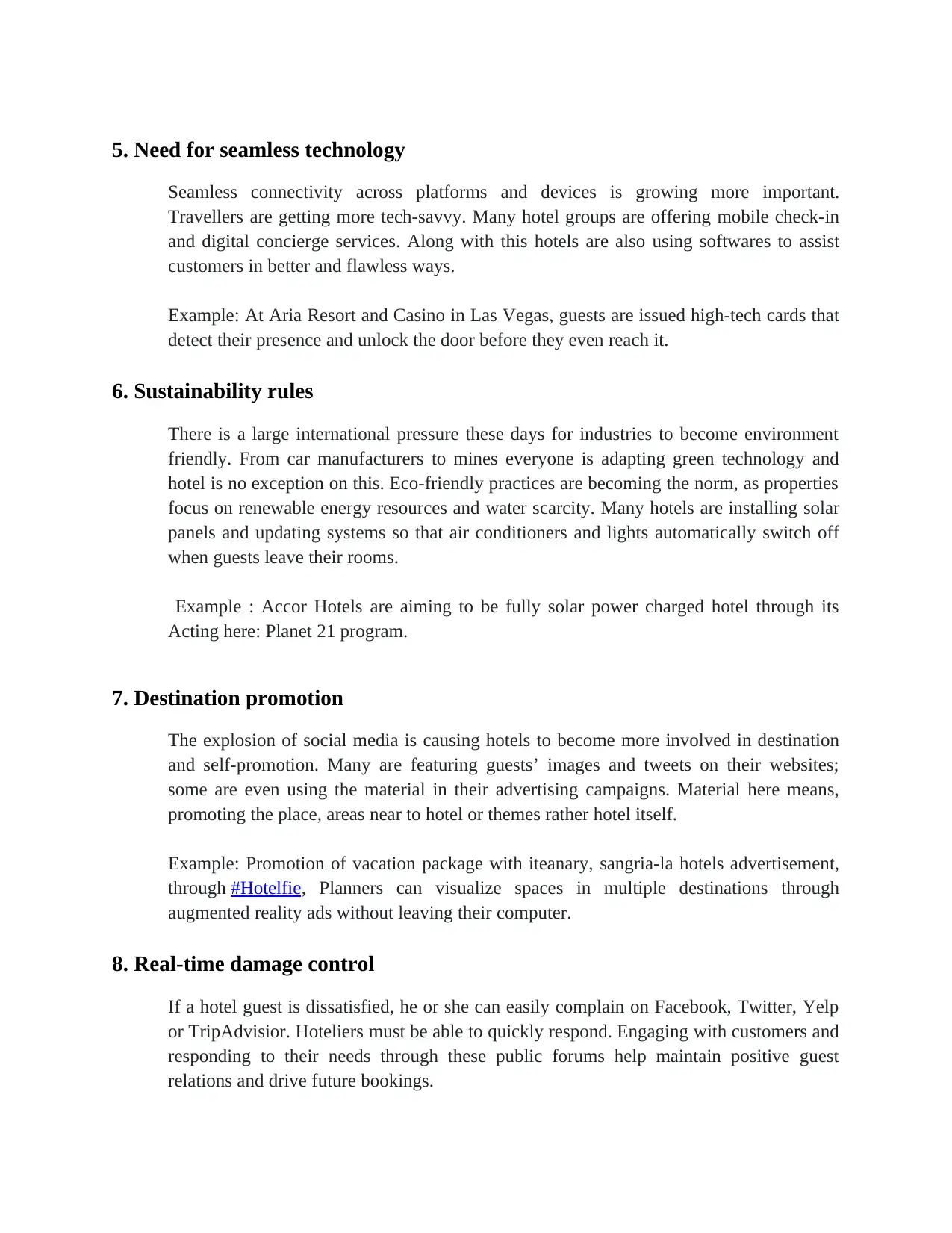
5. Need for seamless technology
Seamless connectivity across platforms and devices is growing more important.
Travellers are getting more tech-savvy. Many hotel groups are offering mobile check-in
and digital concierge services. Along with this hotels are also using softwares to assist
customers in better and flawless ways.
Example: At Aria Resort and Casino in Las Vegas, guests are issued high-tech cards that
detect their presence and unlock the door before they even reach it.
6. Sustainability rules
There is a large international pressure these days for industries to become environment
friendly. From car manufacturers to mines everyone is adapting green technology and
hotel is no exception on this. Eco-friendly practices are becoming the norm, as properties
focus on renewable energy resources and water scarcity. Many hotels are installing solar
panels and updating systems so that air conditioners and lights automatically switch off
when guests leave their rooms.
Example : Accor Hotels are aiming to be fully solar power charged hotel through its
Acting here: Planet 21 program.
7. Destination promotion
The explosion of social media is causing hotels to become more involved in destination
and self-promotion. Many are featuring guests’ images and tweets on their websites;
some are even using the material in their advertising campaigns. Material here means,
promoting the place, areas near to hotel or themes rather hotel itself.
Example: Promotion of vacation package with iteanary, sangria-la hotels advertisement,
through #Hotelfie, Planners can visualize spaces in multiple destinations through
augmented reality ads without leaving their computer.
8. Real-time damage control
If a hotel guest is dissatisfied, he or she can easily complain on Facebook, Twitter, Yelp
or TripAdvisior. Hoteliers must be able to quickly respond. Engaging with customers and
responding to their needs through these public forums help maintain positive guest
relations and drive future bookings.
Seamless connectivity across platforms and devices is growing more important.
Travellers are getting more tech-savvy. Many hotel groups are offering mobile check-in
and digital concierge services. Along with this hotels are also using softwares to assist
customers in better and flawless ways.
Example: At Aria Resort and Casino in Las Vegas, guests are issued high-tech cards that
detect their presence and unlock the door before they even reach it.
6. Sustainability rules
There is a large international pressure these days for industries to become environment
friendly. From car manufacturers to mines everyone is adapting green technology and
hotel is no exception on this. Eco-friendly practices are becoming the norm, as properties
focus on renewable energy resources and water scarcity. Many hotels are installing solar
panels and updating systems so that air conditioners and lights automatically switch off
when guests leave their rooms.
Example : Accor Hotels are aiming to be fully solar power charged hotel through its
Acting here: Planet 21 program.
7. Destination promotion
The explosion of social media is causing hotels to become more involved in destination
and self-promotion. Many are featuring guests’ images and tweets on their websites;
some are even using the material in their advertising campaigns. Material here means,
promoting the place, areas near to hotel or themes rather hotel itself.
Example: Promotion of vacation package with iteanary, sangria-la hotels advertisement,
through #Hotelfie, Planners can visualize spaces in multiple destinations through
augmented reality ads without leaving their computer.
8. Real-time damage control
If a hotel guest is dissatisfied, he or she can easily complain on Facebook, Twitter, Yelp
or TripAdvisior. Hoteliers must be able to quickly respond. Engaging with customers and
responding to their needs through these public forums help maintain positive guest
relations and drive future bookings.
Secure Best Marks with AI Grader
Need help grading? Try our AI Grader for instant feedback on your assignments.
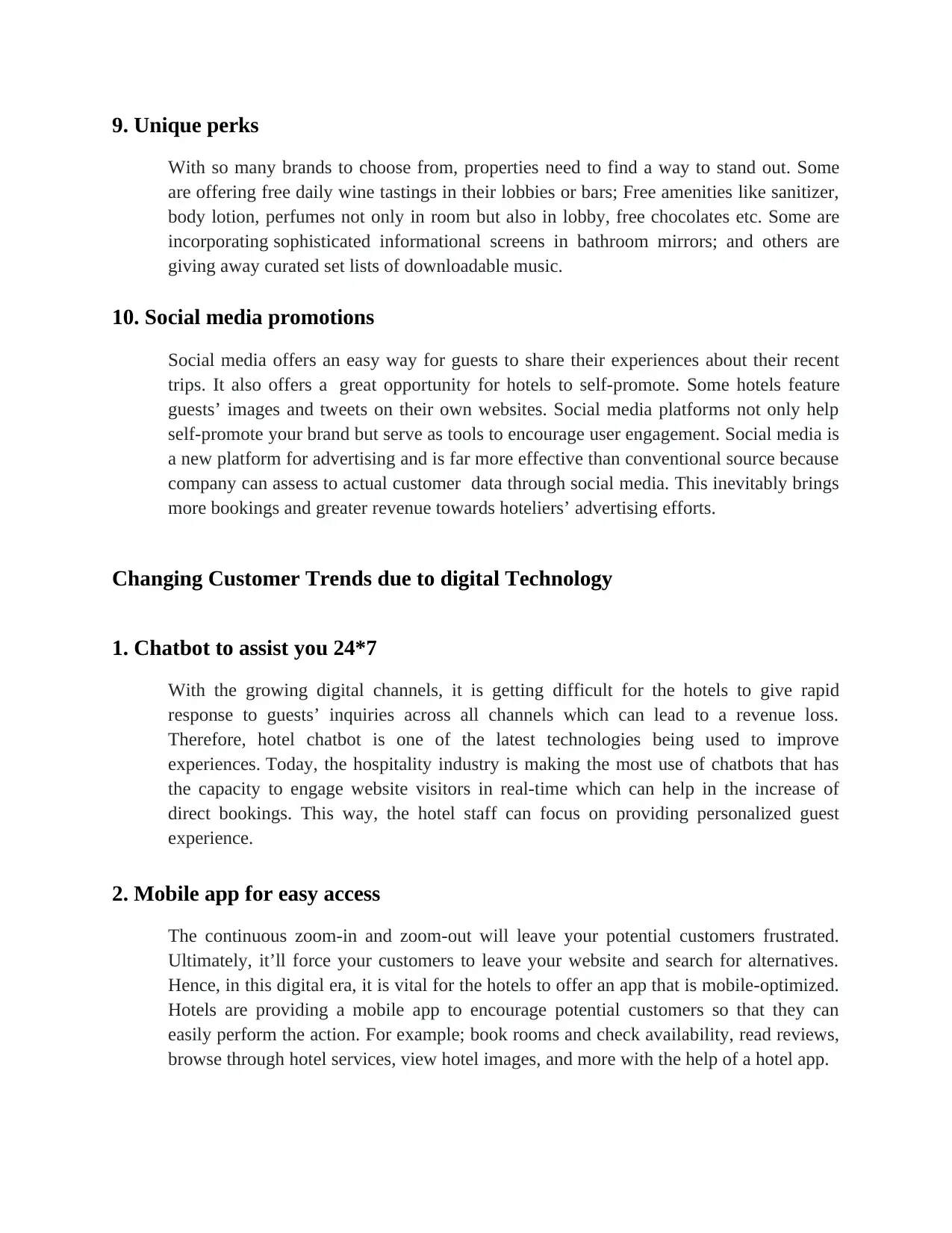
9. Unique perks
With so many brands to choose from, properties need to find a way to stand out. Some
are offering free daily wine tastings in their lobbies or bars; Free amenities like sanitizer,
body lotion, perfumes not only in room but also in lobby, free chocolates etc. Some are
incorporating sophisticated informational screens in bathroom mirrors; and others are
giving away curated set lists of downloadable music.
10. Social media promotions
Social media offers an easy way for guests to share their experiences about their recent
trips. It also offers a great opportunity for hotels to self-promote. Some hotels feature
guests’ images and tweets on their own websites. Social media platforms not only help
self-promote your brand but serve as tools to encourage user engagement. Social media is
a new platform for advertising and is far more effective than conventional source because
company can assess to actual customer data through social media. This inevitably brings
more bookings and greater revenue towards hoteliers’ advertising efforts.
Changing Customer Trends due to digital Technology
1. Chatbot to assist you 24*7
With the growing digital channels, it is getting difficult for the hotels to give rapid
response to guests’ inquiries across all channels which can lead to a revenue loss.
Therefore, hotel chatbot is one of the latest technologies being used to improve
experiences. Today, the hospitality industry is making the most use of chatbots that has
the capacity to engage website visitors in real-time which can help in the increase of
direct bookings. This way, the hotel staff can focus on providing personalized guest
experience.
2. Mobile app for easy access
The continuous zoom-in and zoom-out will leave your potential customers frustrated.
Ultimately, it’ll force your customers to leave your website and search for alternatives.
Hence, in this digital era, it is vital for the hotels to offer an app that is mobile-optimized.
Hotels are providing a mobile app to encourage potential customers so that they can
easily perform the action. For example; book rooms and check availability, read reviews,
browse through hotel services, view hotel images, and more with the help of a hotel app.
With so many brands to choose from, properties need to find a way to stand out. Some
are offering free daily wine tastings in their lobbies or bars; Free amenities like sanitizer,
body lotion, perfumes not only in room but also in lobby, free chocolates etc. Some are
incorporating sophisticated informational screens in bathroom mirrors; and others are
giving away curated set lists of downloadable music.
10. Social media promotions
Social media offers an easy way for guests to share their experiences about their recent
trips. It also offers a great opportunity for hotels to self-promote. Some hotels feature
guests’ images and tweets on their own websites. Social media platforms not only help
self-promote your brand but serve as tools to encourage user engagement. Social media is
a new platform for advertising and is far more effective than conventional source because
company can assess to actual customer data through social media. This inevitably brings
more bookings and greater revenue towards hoteliers’ advertising efforts.
Changing Customer Trends due to digital Technology
1. Chatbot to assist you 24*7
With the growing digital channels, it is getting difficult for the hotels to give rapid
response to guests’ inquiries across all channels which can lead to a revenue loss.
Therefore, hotel chatbot is one of the latest technologies being used to improve
experiences. Today, the hospitality industry is making the most use of chatbots that has
the capacity to engage website visitors in real-time which can help in the increase of
direct bookings. This way, the hotel staff can focus on providing personalized guest
experience.
2. Mobile app for easy access
The continuous zoom-in and zoom-out will leave your potential customers frustrated.
Ultimately, it’ll force your customers to leave your website and search for alternatives.
Hence, in this digital era, it is vital for the hotels to offer an app that is mobile-optimized.
Hotels are providing a mobile app to encourage potential customers so that they can
easily perform the action. For example; book rooms and check availability, read reviews,
browse through hotel services, view hotel images, and more with the help of a hotel app.
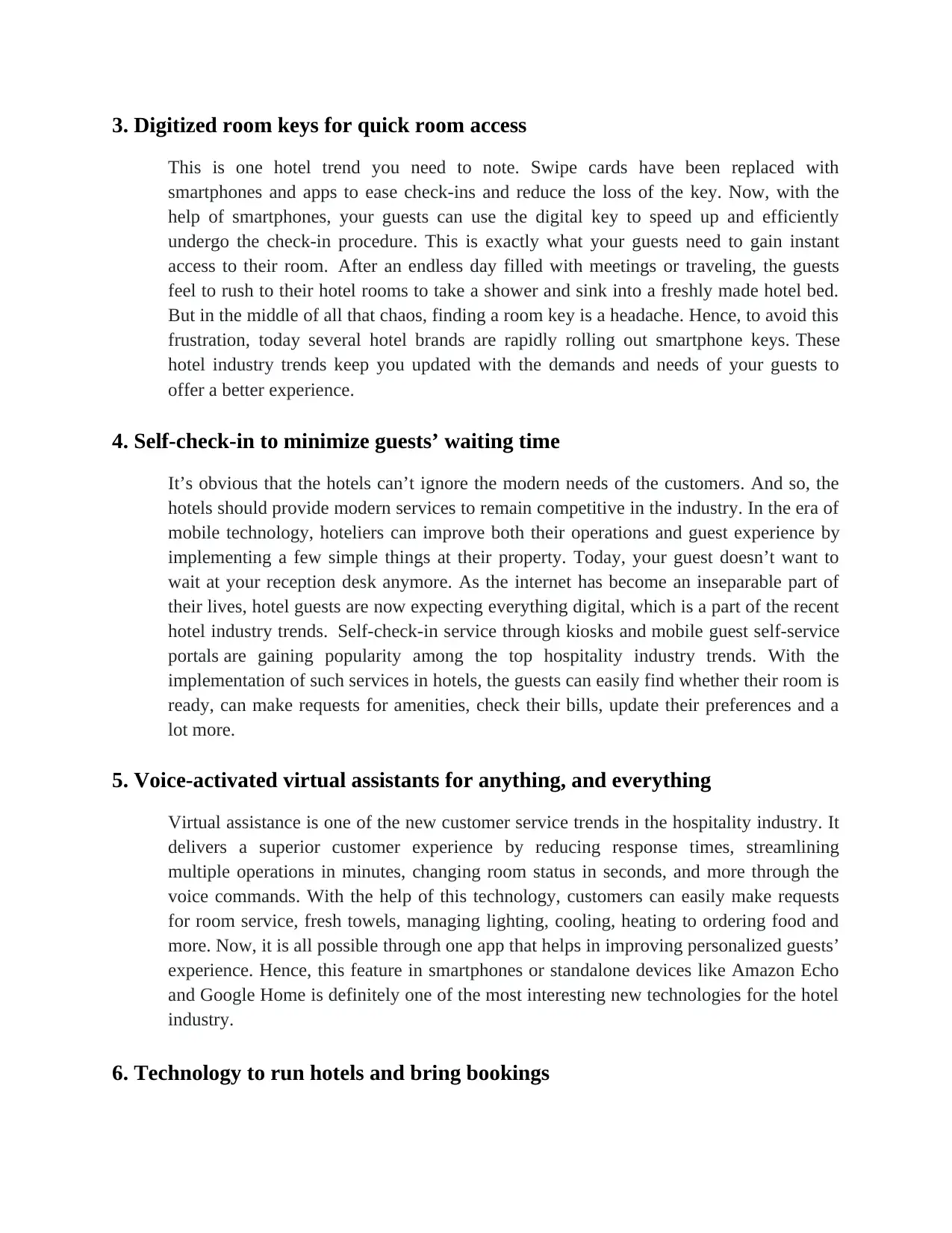
3. Digitized room keys for quick room access
This is one hotel trend you need to note. Swipe cards have been replaced with
smartphones and apps to ease check-ins and reduce the loss of the key. Now, with the
help of smartphones, your guests can use the digital key to speed up and efficiently
undergo the check-in procedure. This is exactly what your guests need to gain instant
access to their room. After an endless day filled with meetings or traveling, the guests
feel to rush to their hotel rooms to take a shower and sink into a freshly made hotel bed.
But in the middle of all that chaos, finding a room key is a headache. Hence, to avoid this
frustration, today several hotel brands are rapidly rolling out smartphone keys. These
hotel industry trends keep you updated with the demands and needs of your guests to
offer a better experience.
4. Self-check-in to minimize guests’ waiting time
It’s obvious that the hotels can’t ignore the modern needs of the customers. And so, the
hotels should provide modern services to remain competitive in the industry. In the era of
mobile technology, hoteliers can improve both their operations and guest experience by
implementing a few simple things at their property. Today, your guest doesn’t want to
wait at your reception desk anymore. As the internet has become an inseparable part of
their lives, hotel guests are now expecting everything digital, which is a part of the recent
hotel industry trends. Self-check-in service through kiosks and mobile guest self-service
portals are gaining popularity among the top hospitality industry trends. With the
implementation of such services in hotels, the guests can easily find whether their room is
ready, can make requests for amenities, check their bills, update their preferences and a
lot more.
5. Voice-activated virtual assistants for anything, and everything
Virtual assistance is one of the new customer service trends in the hospitality industry. It
delivers a superior customer experience by reducing response times, streamlining
multiple operations in minutes, changing room status in seconds, and more through the
voice commands. With the help of this technology, customers can easily make requests
for room service, fresh towels, managing lighting, cooling, heating to ordering food and
more. Now, it is all possible through one app that helps in improving personalized guests’
experience. Hence, this feature in smartphones or standalone devices like Amazon Echo
and Google Home is definitely one of the most interesting new technologies for the hotel
industry.
6. Technology to run hotels and bring bookings
This is one hotel trend you need to note. Swipe cards have been replaced with
smartphones and apps to ease check-ins and reduce the loss of the key. Now, with the
help of smartphones, your guests can use the digital key to speed up and efficiently
undergo the check-in procedure. This is exactly what your guests need to gain instant
access to their room. After an endless day filled with meetings or traveling, the guests
feel to rush to their hotel rooms to take a shower and sink into a freshly made hotel bed.
But in the middle of all that chaos, finding a room key is a headache. Hence, to avoid this
frustration, today several hotel brands are rapidly rolling out smartphone keys. These
hotel industry trends keep you updated with the demands and needs of your guests to
offer a better experience.
4. Self-check-in to minimize guests’ waiting time
It’s obvious that the hotels can’t ignore the modern needs of the customers. And so, the
hotels should provide modern services to remain competitive in the industry. In the era of
mobile technology, hoteliers can improve both their operations and guest experience by
implementing a few simple things at their property. Today, your guest doesn’t want to
wait at your reception desk anymore. As the internet has become an inseparable part of
their lives, hotel guests are now expecting everything digital, which is a part of the recent
hotel industry trends. Self-check-in service through kiosks and mobile guest self-service
portals are gaining popularity among the top hospitality industry trends. With the
implementation of such services in hotels, the guests can easily find whether their room is
ready, can make requests for amenities, check their bills, update their preferences and a
lot more.
5. Voice-activated virtual assistants for anything, and everything
Virtual assistance is one of the new customer service trends in the hospitality industry. It
delivers a superior customer experience by reducing response times, streamlining
multiple operations in minutes, changing room status in seconds, and more through the
voice commands. With the help of this technology, customers can easily make requests
for room service, fresh towels, managing lighting, cooling, heating to ordering food and
more. Now, it is all possible through one app that helps in improving personalized guests’
experience. Hence, this feature in smartphones or standalone devices like Amazon Echo
and Google Home is definitely one of the most interesting new technologies for the hotel
industry.
6. Technology to run hotels and bring bookings
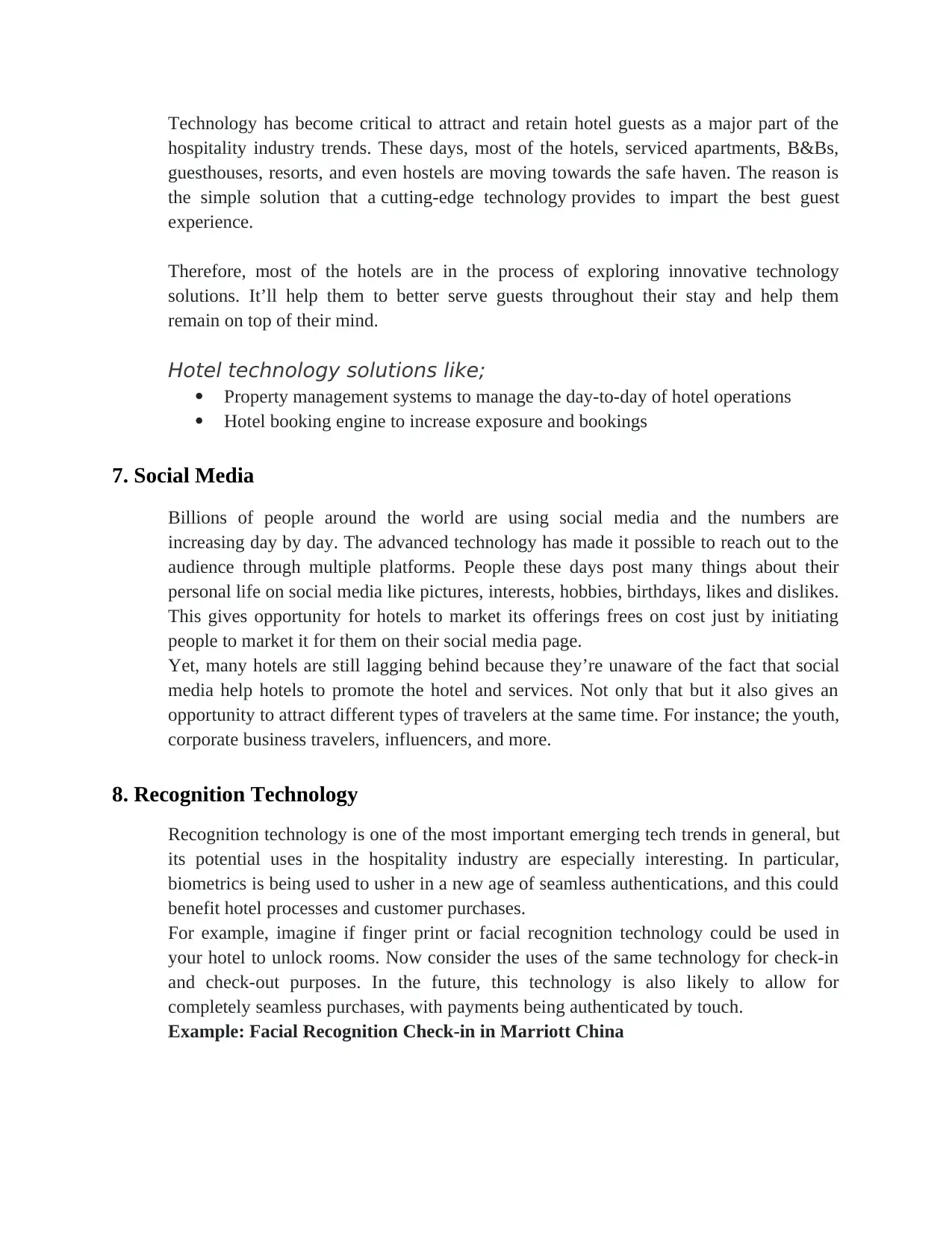
Technology has become critical to attract and retain hotel guests as a major part of the
hospitality industry trends. These days, most of the hotels, serviced apartments, B&Bs,
guesthouses, resorts, and even hostels are moving towards the safe haven. The reason is
the simple solution that a cutting-edge technology provides to impart the best guest
experience.
Therefore, most of the hotels are in the process of exploring innovative technology
solutions. It’ll help them to better serve guests throughout their stay and help them
remain on top of their mind.
Hotel technology solutions like;
Property management systems to manage the day-to-day of hotel operations
Hotel booking engine to increase exposure and bookings
7. Social Media
Billions of people around the world are using social media and the numbers are
increasing day by day. The advanced technology has made it possible to reach out to the
audience through multiple platforms. People these days post many things about their
personal life on social media like pictures, interests, hobbies, birthdays, likes and dislikes.
This gives opportunity for hotels to market its offerings frees on cost just by initiating
people to market it for them on their social media page.
Yet, many hotels are still lagging behind because they’re unaware of the fact that social
media help hotels to promote the hotel and services. Not only that but it also gives an
opportunity to attract different types of travelers at the same time. For instance; the youth,
corporate business travelers, influencers, and more.
8. Recognition Technology
Recognition technology is one of the most important emerging tech trends in general, but
its potential uses in the hospitality industry are especially interesting. In particular,
biometrics is being used to usher in a new age of seamless authentications, and this could
benefit hotel processes and customer purchases.
For example, imagine if finger print or facial recognition technology could be used in
your hotel to unlock rooms. Now consider the uses of the same technology for check-in
and check-out purposes. In the future, this technology is also likely to allow for
completely seamless purchases, with payments being authenticated by touch.
Example: Facial Recognition Check-in in Marriott China
hospitality industry trends. These days, most of the hotels, serviced apartments, B&Bs,
guesthouses, resorts, and even hostels are moving towards the safe haven. The reason is
the simple solution that a cutting-edge technology provides to impart the best guest
experience.
Therefore, most of the hotels are in the process of exploring innovative technology
solutions. It’ll help them to better serve guests throughout their stay and help them
remain on top of their mind.
Hotel technology solutions like;
Property management systems to manage the day-to-day of hotel operations
Hotel booking engine to increase exposure and bookings
7. Social Media
Billions of people around the world are using social media and the numbers are
increasing day by day. The advanced technology has made it possible to reach out to the
audience through multiple platforms. People these days post many things about their
personal life on social media like pictures, interests, hobbies, birthdays, likes and dislikes.
This gives opportunity for hotels to market its offerings frees on cost just by initiating
people to market it for them on their social media page.
Yet, many hotels are still lagging behind because they’re unaware of the fact that social
media help hotels to promote the hotel and services. Not only that but it also gives an
opportunity to attract different types of travelers at the same time. For instance; the youth,
corporate business travelers, influencers, and more.
8. Recognition Technology
Recognition technology is one of the most important emerging tech trends in general, but
its potential uses in the hospitality industry are especially interesting. In particular,
biometrics is being used to usher in a new age of seamless authentications, and this could
benefit hotel processes and customer purchases.
For example, imagine if finger print or facial recognition technology could be used in
your hotel to unlock rooms. Now consider the uses of the same technology for check-in
and check-out purposes. In the future, this technology is also likely to allow for
completely seamless purchases, with payments being authenticated by touch.
Example: Facial Recognition Check-in in Marriott China
Paraphrase This Document
Need a fresh take? Get an instant paraphrase of this document with our AI Paraphraser
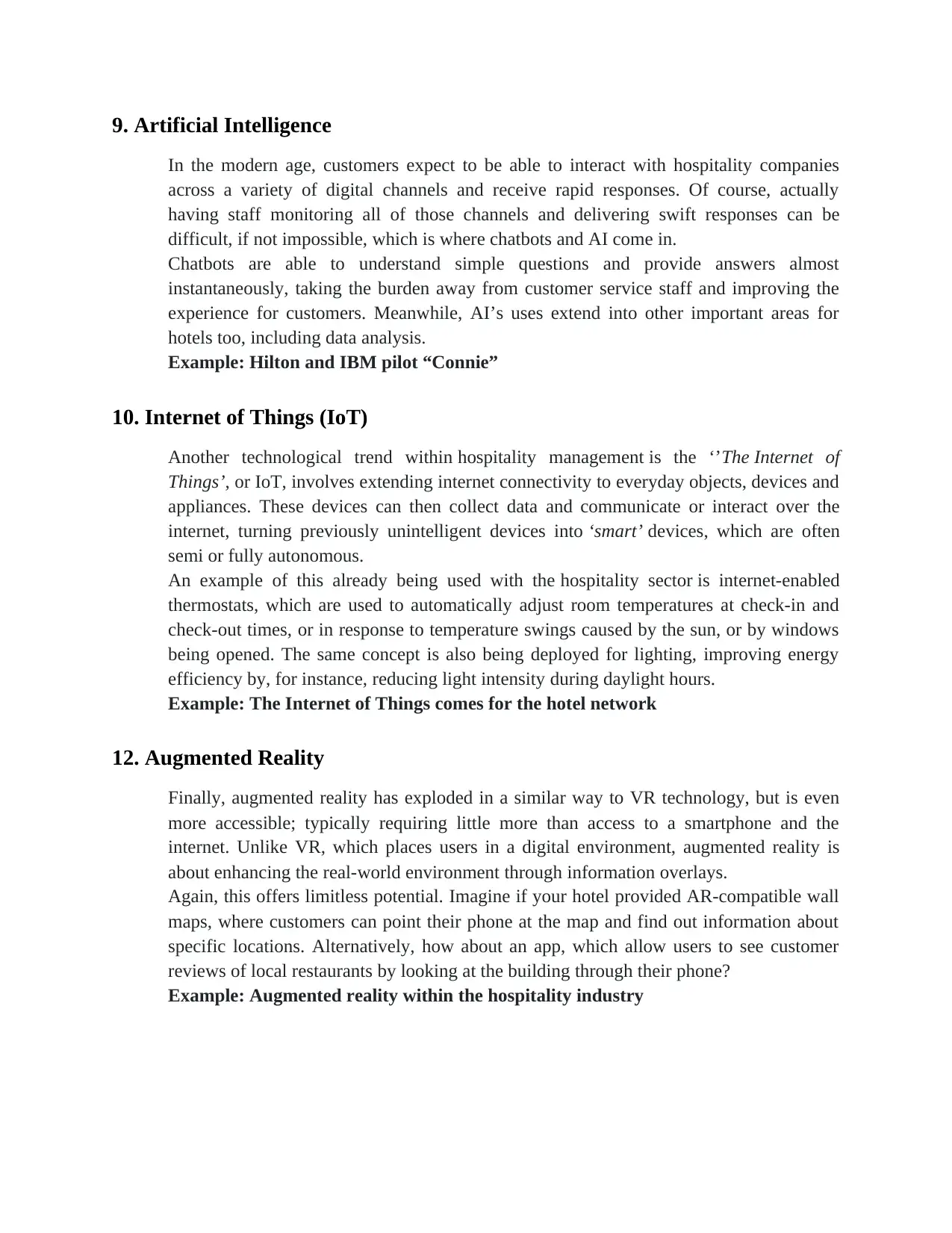
9. Artificial Intelligence
In the modern age, customers expect to be able to interact with hospitality companies
across a variety of digital channels and receive rapid responses. Of course, actually
having staff monitoring all of those channels and delivering swift responses can be
difficult, if not impossible, which is where chatbots and AI come in.
Chatbots are able to understand simple questions and provide answers almost
instantaneously, taking the burden away from customer service staff and improving the
experience for customers. Meanwhile, AI’s uses extend into other important areas for
hotels too, including data analysis.
Example: Hilton and IBM pilot “Connie”
10. Internet of Things (IoT)
Another technological trend within hospitality management is the ‘’The Internet of
Things’, or IoT, involves extending internet connectivity to everyday objects, devices and
appliances. These devices can then collect data and communicate or interact over the
internet, turning previously unintelligent devices into ‘smart’ devices, which are often
semi or fully autonomous.
An example of this already being used with the hospitality sector is internet-enabled
thermostats, which are used to automatically adjust room temperatures at check-in and
check-out times, or in response to temperature swings caused by the sun, or by windows
being opened. The same concept is also being deployed for lighting, improving energy
efficiency by, for instance, reducing light intensity during daylight hours.
Example: The Internet of Things comes for the hotel network
12. Augmented Reality
Finally, augmented reality has exploded in a similar way to VR technology, but is even
more accessible; typically requiring little more than access to a smartphone and the
internet. Unlike VR, which places users in a digital environment, augmented reality is
about enhancing the real-world environment through information overlays.
Again, this offers limitless potential. Imagine if your hotel provided AR-compatible wall
maps, where customers can point their phone at the map and find out information about
specific locations. Alternatively, how about an app, which allow users to see customer
reviews of local restaurants by looking at the building through their phone?
Example: Augmented reality within the hospitality industry
In the modern age, customers expect to be able to interact with hospitality companies
across a variety of digital channels and receive rapid responses. Of course, actually
having staff monitoring all of those channels and delivering swift responses can be
difficult, if not impossible, which is where chatbots and AI come in.
Chatbots are able to understand simple questions and provide answers almost
instantaneously, taking the burden away from customer service staff and improving the
experience for customers. Meanwhile, AI’s uses extend into other important areas for
hotels too, including data analysis.
Example: Hilton and IBM pilot “Connie”
10. Internet of Things (IoT)
Another technological trend within hospitality management is the ‘’The Internet of
Things’, or IoT, involves extending internet connectivity to everyday objects, devices and
appliances. These devices can then collect data and communicate or interact over the
internet, turning previously unintelligent devices into ‘smart’ devices, which are often
semi or fully autonomous.
An example of this already being used with the hospitality sector is internet-enabled
thermostats, which are used to automatically adjust room temperatures at check-in and
check-out times, or in response to temperature swings caused by the sun, or by windows
being opened. The same concept is also being deployed for lighting, improving energy
efficiency by, for instance, reducing light intensity during daylight hours.
Example: The Internet of Things comes for the hotel network
12. Augmented Reality
Finally, augmented reality has exploded in a similar way to VR technology, but is even
more accessible; typically requiring little more than access to a smartphone and the
internet. Unlike VR, which places users in a digital environment, augmented reality is
about enhancing the real-world environment through information overlays.
Again, this offers limitless potential. Imagine if your hotel provided AR-compatible wall
maps, where customers can point their phone at the map and find out information about
specific locations. Alternatively, how about an app, which allow users to see customer
reviews of local restaurants by looking at the building through their phone?
Example: Augmented reality within the hospitality industry
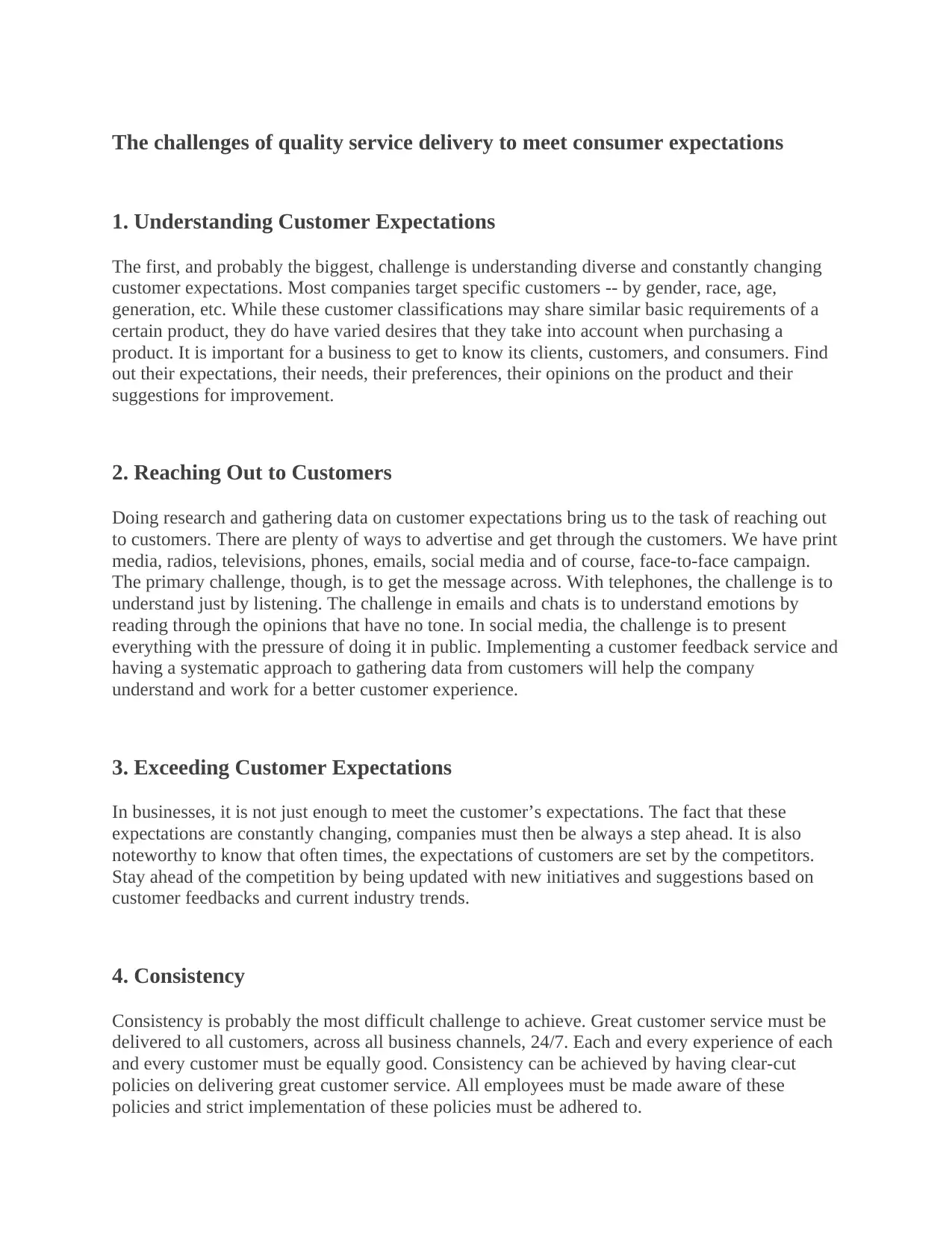
The challenges of quality service delivery to meet consumer expectations
1. Understanding Customer Expectations
The first, and probably the biggest, challenge is understanding diverse and constantly changing
customer expectations. Most companies target specific customers -- by gender, race, age,
generation, etc. While these customer classifications may share similar basic requirements of a
certain product, they do have varied desires that they take into account when purchasing a
product. It is important for a business to get to know its clients, customers, and consumers. Find
out their expectations, their needs, their preferences, their opinions on the product and their
suggestions for improvement.
2. Reaching Out to Customers
Doing research and gathering data on customer expectations bring us to the task of reaching out
to customers. There are plenty of ways to advertise and get through the customers. We have print
media, radios, televisions, phones, emails, social media and of course, face-to-face campaign.
The primary challenge, though, is to get the message across. With telephones, the challenge is to
understand just by listening. The challenge in emails and chats is to understand emotions by
reading through the opinions that have no tone. In social media, the challenge is to present
everything with the pressure of doing it in public. Implementing a customer feedback service and
having a systematic approach to gathering data from customers will help the company
understand and work for a better customer experience.
3. Exceeding Customer Expectations
In businesses, it is not just enough to meet the customer’s expectations. The fact that these
expectations are constantly changing, companies must then be always a step ahead. It is also
noteworthy to know that often times, the expectations of customers are set by the competitors.
Stay ahead of the competition by being updated with new initiatives and suggestions based on
customer feedbacks and current industry trends.
4. Consistency
Consistency is probably the most difficult challenge to achieve. Great customer service must be
delivered to all customers, across all business channels, 24/7. Each and every experience of each
and every customer must be equally good. Consistency can be achieved by having clear-cut
policies on delivering great customer service. All employees must be made aware of these
policies and strict implementation of these policies must be adhered to.
1. Understanding Customer Expectations
The first, and probably the biggest, challenge is understanding diverse and constantly changing
customer expectations. Most companies target specific customers -- by gender, race, age,
generation, etc. While these customer classifications may share similar basic requirements of a
certain product, they do have varied desires that they take into account when purchasing a
product. It is important for a business to get to know its clients, customers, and consumers. Find
out their expectations, their needs, their preferences, their opinions on the product and their
suggestions for improvement.
2. Reaching Out to Customers
Doing research and gathering data on customer expectations bring us to the task of reaching out
to customers. There are plenty of ways to advertise and get through the customers. We have print
media, radios, televisions, phones, emails, social media and of course, face-to-face campaign.
The primary challenge, though, is to get the message across. With telephones, the challenge is to
understand just by listening. The challenge in emails and chats is to understand emotions by
reading through the opinions that have no tone. In social media, the challenge is to present
everything with the pressure of doing it in public. Implementing a customer feedback service and
having a systematic approach to gathering data from customers will help the company
understand and work for a better customer experience.
3. Exceeding Customer Expectations
In businesses, it is not just enough to meet the customer’s expectations. The fact that these
expectations are constantly changing, companies must then be always a step ahead. It is also
noteworthy to know that often times, the expectations of customers are set by the competitors.
Stay ahead of the competition by being updated with new initiatives and suggestions based on
customer feedbacks and current industry trends.
4. Consistency
Consistency is probably the most difficult challenge to achieve. Great customer service must be
delivered to all customers, across all business channels, 24/7. Each and every experience of each
and every customer must be equally good. Consistency can be achieved by having clear-cut
policies on delivering great customer service. All employees must be made aware of these
policies and strict implementation of these policies must be adhered to.
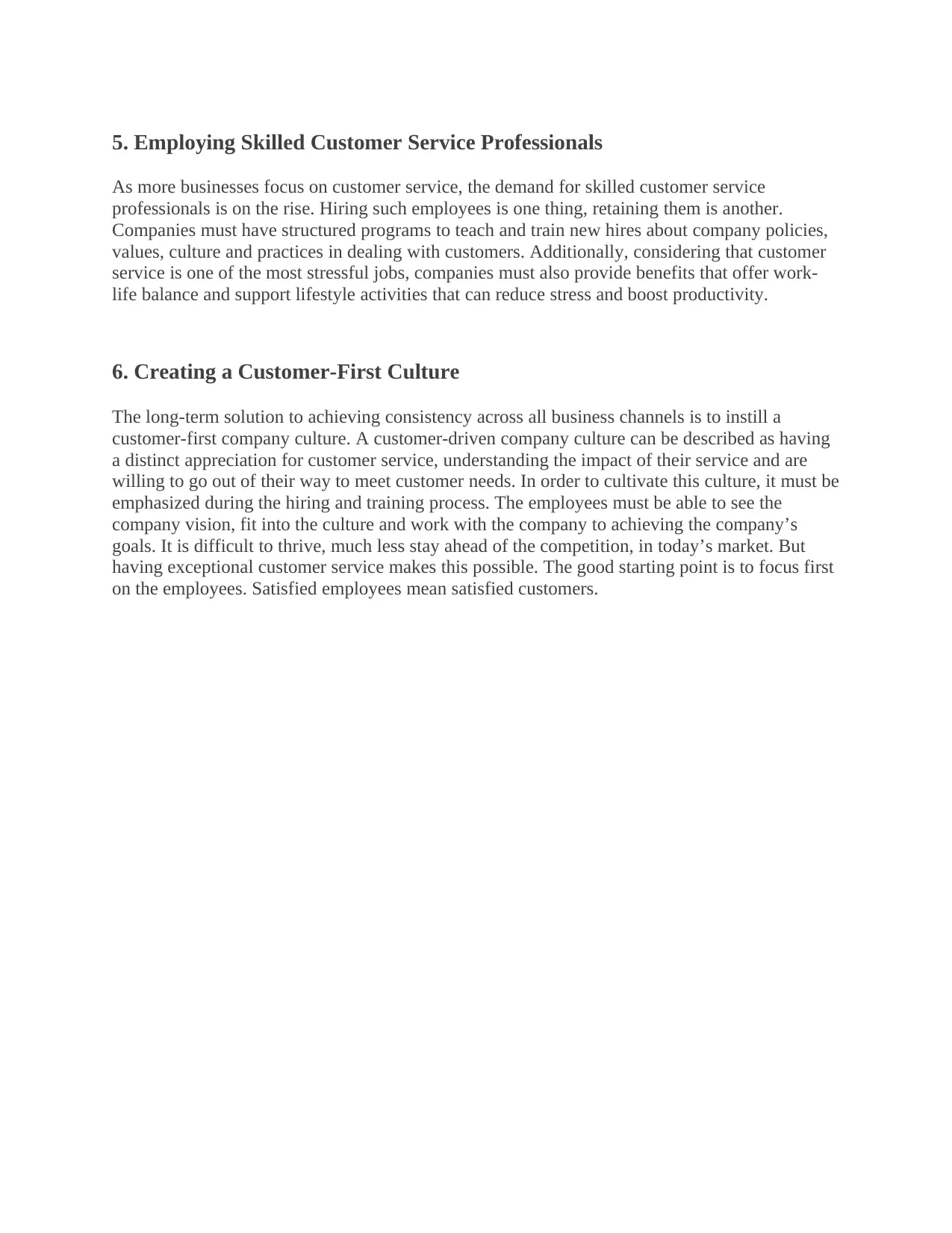
5. Employing Skilled Customer Service Professionals
As more businesses focus on customer service, the demand for skilled customer service
professionals is on the rise. Hiring such employees is one thing, retaining them is another.
Companies must have structured programs to teach and train new hires about company policies,
values, culture and practices in dealing with customers. Additionally, considering that customer
service is one of the most stressful jobs, companies must also provide benefits that offer work-
life balance and support lifestyle activities that can reduce stress and boost productivity.
6. Creating a Customer-First Culture
The long-term solution to achieving consistency across all business channels is to instill a
customer-first company culture. A customer-driven company culture can be described as having
a distinct appreciation for customer service, understanding the impact of their service and are
willing to go out of their way to meet customer needs. In order to cultivate this culture, it must be
emphasized during the hiring and training process. The employees must be able to see the
company vision, fit into the culture and work with the company to achieving the company’s
goals. It is difficult to thrive, much less stay ahead of the competition, in today’s market. But
having exceptional customer service makes this possible. The good starting point is to focus first
on the employees. Satisfied employees mean satisfied customers.
As more businesses focus on customer service, the demand for skilled customer service
professionals is on the rise. Hiring such employees is one thing, retaining them is another.
Companies must have structured programs to teach and train new hires about company policies,
values, culture and practices in dealing with customers. Additionally, considering that customer
service is one of the most stressful jobs, companies must also provide benefits that offer work-
life balance and support lifestyle activities that can reduce stress and boost productivity.
6. Creating a Customer-First Culture
The long-term solution to achieving consistency across all business channels is to instill a
customer-first company culture. A customer-driven company culture can be described as having
a distinct appreciation for customer service, understanding the impact of their service and are
willing to go out of their way to meet customer needs. In order to cultivate this culture, it must be
emphasized during the hiring and training process. The employees must be able to see the
company vision, fit into the culture and work with the company to achieving the company’s
goals. It is difficult to thrive, much less stay ahead of the competition, in today’s market. But
having exceptional customer service makes this possible. The good starting point is to focus first
on the employees. Satisfied employees mean satisfied customers.
1 out of 16
Related Documents
Your All-in-One AI-Powered Toolkit for Academic Success.
+13062052269
info@desklib.com
Available 24*7 on WhatsApp / Email
![[object Object]](/_next/static/media/star-bottom.7253800d.svg)
Unlock your academic potential
© 2024 | Zucol Services PVT LTD | All rights reserved.


